Using Fluid Candidate Gateway to Apply for Jobs
This topic discusses how applicants complete an online job application.
These videos demonstrate Fluid Candidate Gateway, including the job application process:
Video: Fluid Candidate Gateway Video Feature Overview
Video: PeopleSoft HCM 9.2 Image 18 Highlights: Fluid Candidate Gateway
Video: PeopleSoft HCM 9.2 Image 19 Highlights: Fluid Candidate Gateway Enhancements
Note: External applicants must sign in before starting a job application. The system prompts applicants to sign in if necessary.
|
Page Name |
Definition Name |
Usage |
|---|---|---|
|
The Activity Guide Framework for Job Applications (common elements on pages used to apply for jobs) |
n/a |
In Fluid Candidate Gateway, the application appears within the context of a PeopleTools Activity Guide. The Activity Guide shows the steps in the application process and provides navigation buttons for proceeding through the steps. |
|
HRS_CE_START_FL |
Review notices and accept any terms and conditions. If none exist, this page does not appear. |
|
|
HRS_CE_TERMS_SCF |
Review any terms or conditions that must be agreed to before continuing the application. |
|
|
HRS_APP_JOPRESC_FL (for applications with a job opening) HRS_APP_PRESCRN_FL (for applications without a job opening) |
Answer prescreening questions. |
|
|
HRS_JPSCR_RSLT_SCF (for applications with a job opening) HRS_PSCR_RSLT_SCF (for applications without a job opening) |
Review prescreening results when the applicant fails prescreening for at least one job. |
|
|
HRS_RESUME_OPTN_FL |
Supply resume and cover letter attachments for the application. |
|
|
HRS_RESUMES_SCF |
Select a previously submitted resume to associate with the job application. |
|
|
HRS_RES_PASTE_SCF |
View a resume that was pasted into an application. Applicants cannot paste resumes into applications in Fluid Candidate Gateway, but they can use pasted resumes from applications that were started in classic Candidate Gateway. |
|
|
<Step Name> Page (page title is configured on the resume template) |
HRS_CE_PROFILE_FL |
Enter application data using steps that are defined on the resume template. These are the sections that can be configured to appear:
|
|
HRS_CE_D_ATTCH_SCF |
Enter attachment information and initiate the file upload process. |
|
|
HRS_CE_G_D_PP_SCF |
Enter U.S. Federal priority placement information. |
|
|
HRS_CE_D_WRK_SCF |
Enter work experience details. |
|
|
HRS_CE_D_TRAIN_SCF |
Enter job training details. |
|
|
HRS_CE_D_JPM_A_SCF (when adding a new profile item) HRS_CE_D_JPM_E_SCF (when editing an existing profile item) |
Enter details about a profile-based qualification. |
|
|
HRS_CE_D_REFS_SCF |
Enter name and contact details for a reference. |
|
|
HRS_APP_CB2_FL |
Enter community background information for Northern Ireland. |
|
|
HRS_CE_DISABILI_FL |
Enter disability information. This page supports compliance with regulations from the U.S. Department of Labor’s Office of Federal Contract Compliance Programs (OFCCP). |
|
|
HRS_CE_VETERAN_FL |
Enter veteran information. This page supports compliance with OFCCP regulations from the U.S. Department of Labor. |
|
|
HRS_CE_SELF_IDE_FL |
Enter gender and ethnicity information for equal employment opportunity reporting in the United States. |
|
|
Ethnic Group Page or Race Page |
HRS_CE_DIV_EXP_SCF |
Displays explanatory text to help applicants answer the questions “Are you Hispanic or Latino?” and “What is your race?” These questions appear on the Diversity page when the system is configured to collect ethnicity and race information using a two-part question. To access this page, applicants click the Explain link next to either of the questions on the Diversity page. The page title and content depend on which Explain link is clicked. |
|
HRS_CE_REVIEW_FL |
Review application data and submit an application. |
|
|
HRS_PRFILEINFO_SCF |
External applicants use this page to review and update name and contact information before submitting an application. Internal applicants can review this information, but they cannot make any changes because the information comes from HR records. |
|
|
HRS_CE_CONFIRM_FL |
View a confirmation that an application has been successfully submitted, and review online screening results for job openings that include results messages for online screening. |
|
|
HRS_CE_REVIEW_FL |
Review a submitted application. |
In Fluid Candidate Gateway, the application appears within the context of a PeopleTools Activity Guide.
This example illustrates the Activity Guide framework within which the job application pages appear.

This example illustrates the Activity Guide framework on a small form factor device. In the first image, the step list is hidden. In the second image, the step list is exposed.
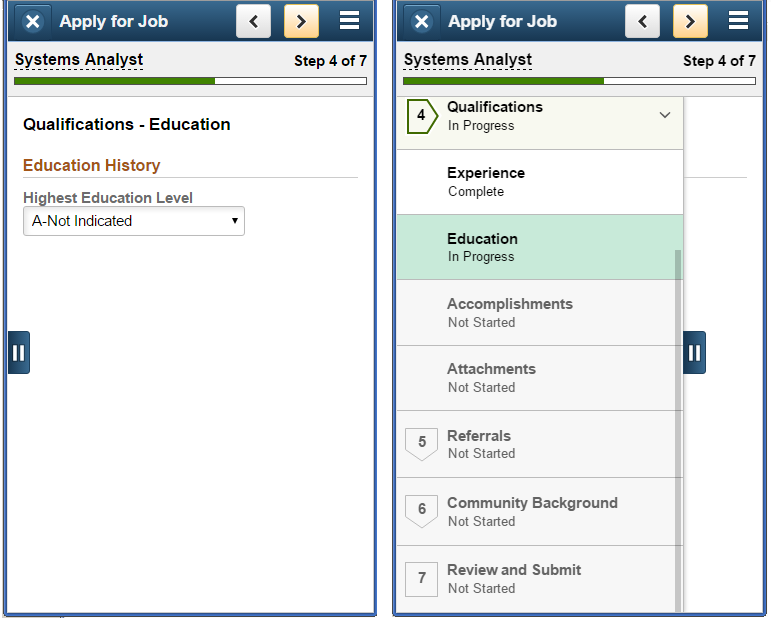
Note: Throughout this topic, the page illustrations show sections of the job application without the context of the Activity Guide step list. Even though the Activity Guide framework is not illustrated, remember that all job application steps appear within that framework.
Page Banner
The blue area at the top of PeopleSoft pages is called the page banner. In other PeopleSoft applications, the banner displays several standard icon buttons.
On most Candidate Gateway pages, internal applicants see the standard set of banner icon buttons. However, in the job application Activity Guide, only the Notification and Actions List icon buttons are visible.
External applicants don’t see any of the standard banner icon buttons except for the Actions List.
Field or Control |
Description |
|---|---|
|
Clicking this button exits the application. If the applicant has not moved past the Start step, the system does not save the application. Otherwise, the system saves the application before exiting, and the application appears on the My Job Applications Page page as an unsubmitted application. The applicant can resume the application later. |
|
Clicking this button saves changes to the current step and navigates to the previous step or substep. The button is not visible on the first step in the application. |
|
Clicking this button saves changes to the current step and navigates to the next step or substep. If any required information is missing on the current step, a message appears, and the applicant must provide the missing information before continuing to the next step. On the last step of the application (the Review and Submit step), the Next button is replaced by a Submit button. |
Submit |
This button appears only on the Review and Submit step. An applicant clicks this button to submit the application. Applicants cannot make any further changes to an application that has been submitted. To provide an updated application, the applicant can re-apply. If the site is configured not to allow multiple applications for a job opening, the applicant can withdraw the original application before reapplying. Applications that have been submitted appear on the My Job Applications page with the status Submitted. |
|
Within a job application Activity Guide, the Actions List in the banner includes one item: Save As Draft. Selecting this option saves an in-progress application without moving to a new page or exiting the application. Saving as draft before moving past the Start Step does not create a draft application because there is no application information to save. Note: You can control the positioning of ‘Save As Draft’ button by site setup. For more information, see Site Setup Page |
Note: The Exit, Previous, and Next buttons appear as icon buttons on small form factor devices and as text buttons on larger form factors. The Submit button is a text button on all devices.
Job Application Header
A gray area under the main page banner displays contextual information that is specific to the job application.
Field or Control |
Description |
|---|---|
<Job Posting Title> |
Displays the posting title of the job. Clicking the posting title displays a pop-up window with the job title, location, and job ID. If the application is for multiple jobs, the text indicates the number of jobs in the application, and the pop-up window lists information about each job. If an applicant fails prescreening for a some of the jobs in a multi-job application, the system removes those jobs from the list of job openings. If the applicant applied without selecting a job, the applicant sees the text You have not selected a job. |
<Progress Indicator> (small form factor only) |
Small form factor screens don’t have room to show the panel with the list of steps at the same time as the current step. Therefore, these devices display a progress indicator in the page header. The progress indicator consists of:
|
List of Steps
The Activity Guide framework includes a panel that lists the steps in the job application process. This panel appears on the left on devices other than small form factor devices. On a small form factor such as phone, the panel is initially hidden.
Field or Control |
Description |
|---|---|
|
On a small form factor device, tap this button to show or hide the panel with the list of steps. |
<Step Name> |
On the panel with the list of steps, individual steps are numbered and labeled. The current step is highlighted. Depending on the resume template configuration, some steps may have substeps. These are indicated by an expand/collapse icon next to the step name. The step is automatically expanded when the applicant reaches it. The applicant can also click the parent step at any time to expand or collapse it. Substeps are not numbered. All required information on a step must be complete before an applicant is allowed to move to a different step. If any required information is missing, a message appears, and the applicant must provide the missing information before continuing. |
<Step Status> |
Each step and substep has a status.
Applicants cannot use the step list to access Not Started steps. Instead, applicants must use the Next button to navigate to unvisited steps and substeps in sequence. Applicants can return to Complete and In Progress steps and substeps by clicking the step. When the applicant returns to an earlier step, then that step and any completed steps that follow the now-current step still remain in Completed status. |
Job Application Pages
Within the Activity Guide framework, the main panel displays the page for the current step in the job application.
Field or Control |
Description |
|---|---|
<Title Text> |
Displays a page title that includes the step number and step name—for example, Step 1 of 8: Start For substeps, the page title includes both the step and substep name, separated by a hyphen. For example, Step 4 of 8: Qualifications - Experience indicates that the step title is Qualifications and the substep title is Experience. |
Applicants use the Start page (HRS_CE_START_FL) to review notices and accept any terms and conditions.
If no notices exist, this page does not appear. Job applications that include prescreening always include notices.
Navigation:
Begin a job application. To do this:
Click the Apply for Job button on the Job Description page.
If applications for multiple jobs are allowed, click the Apply for Job button on the Search Jobs page or the My Favorite Jobs page.
If applying without a job is allowed, click the Apply Without a Job link on the Search Jobs page.
This example illustrates the Start page with sample text. Oracle delivers these sample text examples.
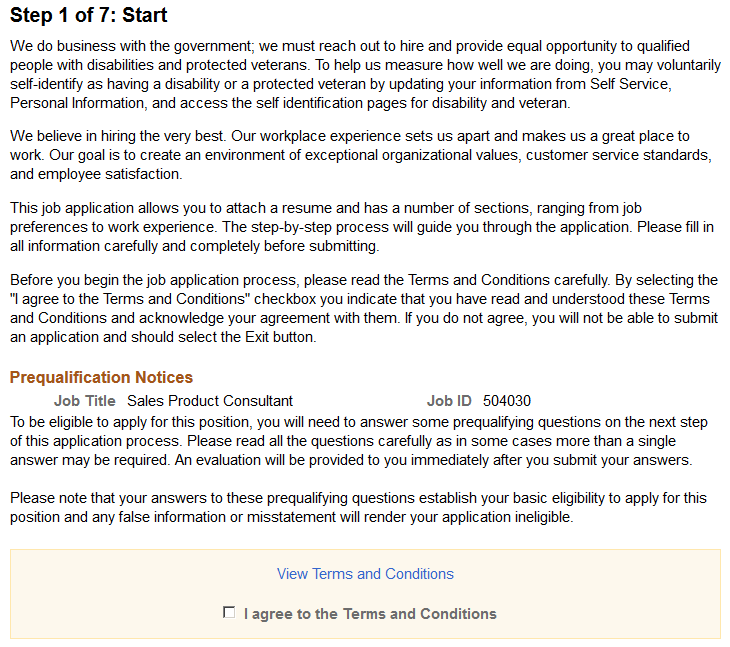
This illustration of the Start page replaces the sample notices with descriptions of each notice and the text catalog ID for each notice.

Terms and Conditions page when Acknowledgement configuration is used for Prequalification and Application Agreements.
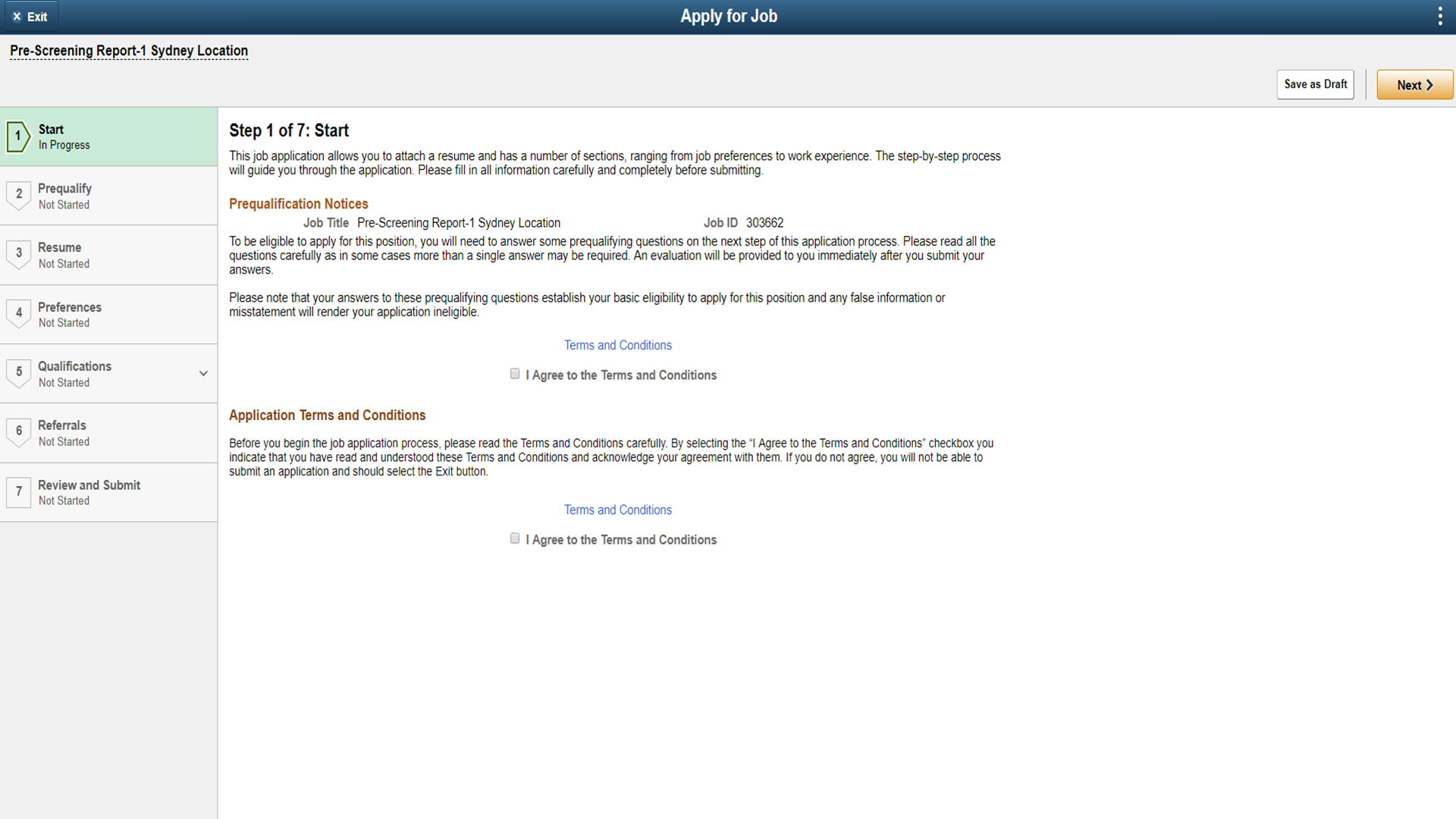
This example illustrates the Start page with guided process instruction text.

Note: The following definitions refer to the notices using the descriptions on the illustration above.
Field or Control |
Description |
|---|---|
1. OFCCP Invitation to Voluntarily Self-Identify |
Appears only for internal applicants, and only if the OFCCP Self-Identify field on the Site Setup Page page is configured to request veteran or disability self-identification from applicants. This notice (text catalog ID HRAM_FL_DIS_INSTR4) informs internal applicants that they can use HR self-service to voluntarily self-identify as having a disability or a protected veteran status. This notice is shown to internal applicants in lieu of collecting self-identification information during the application process. |
2. Start Step Administrator Configured Text |
Appears only if the Display Start Step Administrator Configured Text check box is selected on the Site Setup page. This notice (text catalog ID HRAM_FL_ADMIN_TXT) can serve any purpose. For example, use it to introduce your organization, make announcements, and so forth. |
3. Start Step Instructional Text |
Appears only if the Display Start Step Instructional Text check box is selected on the Site Setup page. This notice (text catalog ID HRAM_FL_INSTR_TXT) is intended for general instructions related to the application process. It should not be used for instructions related to terms and conditions, as a separate text block exists for that purpose. |
|
4. Start Step Guided Process Instructional Text |
Appears only if the Display Start Step Guided Process Instructional Text check box is selected on the Site Setup page. This notice (text catalog ID HRAM_FL_GP_INST) is intended for general instructions related to the usage of the Apply for Job guided process. |
5. Instructions for Terms and Conditions |
Appears only if the applicant must agree to any terms and conditions. This occurs if the Display Application Terms and Agreements check box is selected on the Site Setup page or, for jobs with prescreening, if the Display Prequalification Terms and Agreements check box is selected on the Site page. This notice (text catalog ID HRAM_FL_DINSTR_TXT) instructs applicants to read the terms and conditions and explains that they must agree to the terms before continuing. Note: This does not appear if Application Acknowledgement is enabled. |
Prequalification Notices
Field or Control |
Description |
|---|---|
6. Prequalification Notice |
Appears only if the application includes a Prequalify step. You cannot disable prequalification notices. The notice text comes from the Explain Text ID field in the job opening’s prescreening setup (or, if there is no job opening, from the prescreening setup on the resume template). The relevant job title and job ID appear before the notice. If the application includes multiple jobs with prescreening, notices for jobs that use the same Explain Text ID are consolidated. That is, the titles and job IDs for all jobs using a particular notice are listed before the notice. If jobs use different Explain Text IDs, the notices appear sequentially under the appropriate job titles and IDs. |
Terms and Conditions
The Terms an Conditions area of the page appears only if the applicant must agree to terms and conditions before continuing. This occurs if the Display Application Terms and Agreements check box is selected the Site Setup page or, for jobs with prescreening, if the Display Prequalification Terms and Agreements check box is selected on the Site Setup page.
Field or Control |
Description |
|---|---|
View Terms and Conditions |
Click to open the Terms and Conditions page and read the terms and conditions for the application. Note: The system does not force applicants to open the Terms and Conditions page before agreeing to terms and conditions. |
I have read the Terms and Conditions |
When the Terms and Conditions area of the page is visible, applicants must select this check box to indicate consent to the terms and conditions before they can continue to the next step. |
Applicants use the Terms and Conditions page (HRS_CE_TERMS_SCF) to review any terms or conditions that must be agreed to before continuing the application.
Navigation:
Click the View Terms and Conditions link on the Start page.
This example illustrates the Terms and Conditions page with sample text. Oracle delivers this sample text.

This illustration of the Terms and Conditions page replaces the sample terms and conditions with descriptions and the text catalog ID for each text block.

This page is read-only. To close the page, click the x (Close) button in the top right corner of the page.
The following field definitions refer to the text elements using the numbered list on the illustration above.
Field or Control |
Description |
|---|---|
1. Prequalification Terms & Conditions |
Appears only if the application includes prescreening and the Display Prequalification Terms and Agreements check box is selected on the Site Setup page. This text element (text catalog ID HRAM_FL_PREQ_INSTRU) presents terms and conditions related to the prescreening process. |
2. Application Terms & Conditions |
Appears only if the Display Application Terms and Agreements check box is selected on the Site Setup page This text element (text catalog ID HRAM_FL_APPL_INSTR) presents general terms and conditions related to the submission of any job application. |
If an Acknowledgement Configuration is used for specifying the Prequalification Terms and Conditions as well as the Application terms and Conditions, they are displayed differently.
Field or Control |
Description |
|---|---|
Prequalification Notices |
Appears only if the application includes prescreening and the Job Application Acknowledgement check box is selected on the Site Setup Page. The Prequalification Acknowledgement in the Site Setup page can be updated by updating the corresponding Acknowledgement in the Acknowledgement Configuration Page |
Application terms and Conditions |
Appears only if the Job Application Acknowledgement check box is selected on the Site Setup page and the relevant Application Agreement. The Application Agreement in the Site Setup page can be updated by updating the corresponding Acknowledgement in the Acknowledgement Configuration Page |
Applicants use the Prequalify page (HRS_APP_JOPRESC_FL for applications with a job opening, or HRS_APP_PRESCRN_FL for applications without a job opening) to answer prescreening questions.
The Prequalify page appears only in applications that include prescreening.
Navigation:
Click the Next button on the Start step.
This example illustrates the Prequalify page before the applicant continues to the next step.
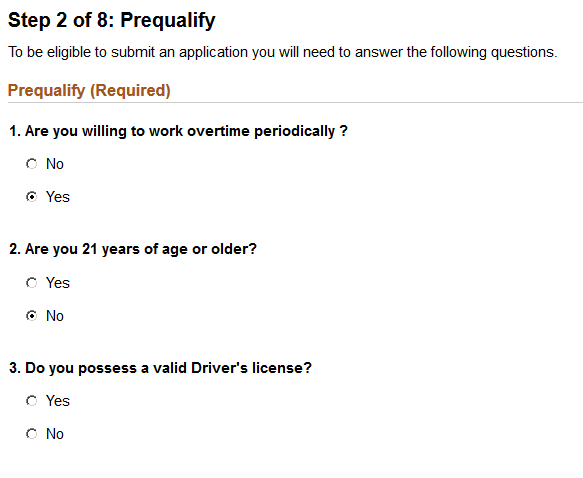
This example illustrates the Prequalify page when an applicant returns to the Prequalify step after continuing to subsequent steps.
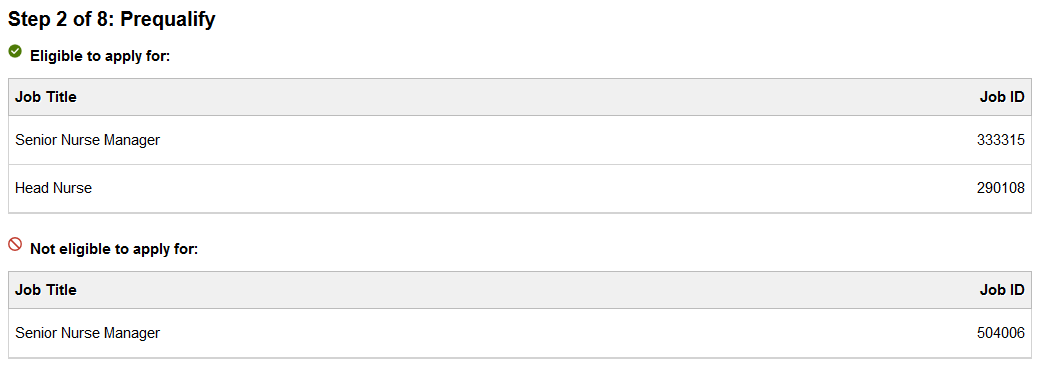
Before Prequalification
Field or Control |
Description |
|---|---|
Prequalify |
This section displays a numbered list of questions. These questions come from the prescreening definition on the job opening (or, for applications without a job opening, from the prescreening definition on the resume template). In a multi-job application, prescreening questions for all jobs are consolidated into one list. Prescreening questions do not have default answers, even if the applicant previously applied for the job. Radio buttons indicate that the question has one correct answer. Check boxes indicate that the question has multiple correct answers. Prescreening questions cannot be open-ended. If the Require Answers to Questions check box on the Site Setup Page is selected, the title above the list of questions includes the word (Required), and applicants must supply answers to all questions before continuing. When the applicant clicks the Next button to continue, the system immediately evaluates the answers and determines whether the applicant passes prescreening. |
After Prequalification
After passing prescreening and continuing to the next step, applicants can return to the Prequalify step, but in this mode, the page displays prescreening results rather than the original prescreening questions.
Field or Control |
Description |
|---|---|
Eligible to apply for |
Displays the Job Title and Job ID of all jobs that passed prescreening. |
Not eligible to apply for |
Displays the Job Title and Job ID of jobs that were removed from the application due to failed prescreening. |
Applicants use the Prequalify Results page (HRS_JPSCR_RSLT_SCF for applications with a job opening, HRS_PSCR_RSLT_SCF for applications without a job opening) to review prescreening results after failing prescreening for at least one job.
The Prequalify Results page does not appear if the applicant passes prescreening for all jobs in the application.
Navigation:
Click the Next button on the Prequalify step.
This example illustrates the Prequalify Results page. In this example, the applicant applied for multiple jobs. The applicant passed prescreening for one job and failed prescreening for another job. A third job in the application did not have any prescreening questions, so it is included in the list of jobs for which the applicant is eligible to apply.
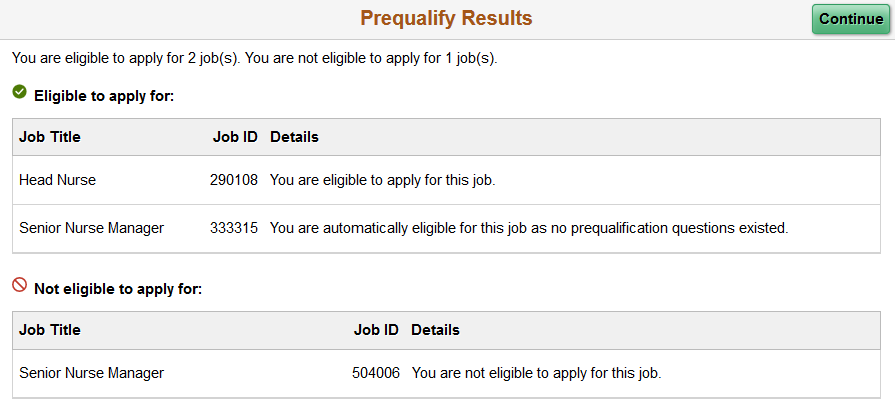
Field or Control |
Description |
|---|---|
Continue |
This button appears only if the applicant is eligible to apply for at least one job. The applicant clicks this button to continue to the next step in the application, but jobs where the applicant failed prescreening are removed from the application. |
x (Close) |
If the applicant is not eligible for any jobs, the dialog box has a close box, but no Continue button. The application process ends when the applicant closes this dialog box. |
Eligible to apply for |
Lists the jobs where the applicant passes prescreening or where no prescreening existed. |
Not eligible to apply for |
Lists the jobs where the applicant failed prescreening. |
Applicants use the Resume page (HRS_RESUME_OPTN_FL) to attach a resume and a cover letter to the application.
The application process includes a Resume step unless the resume template is configured to skip this step.
Navigation:
In the application Activity Guide, click the Next button until you reach this step.
This example illustrates the Resume page before the applicant supplies a resume or cover letter. In this example, the resume template is configured so that a resume is required and a cover letter is optional.
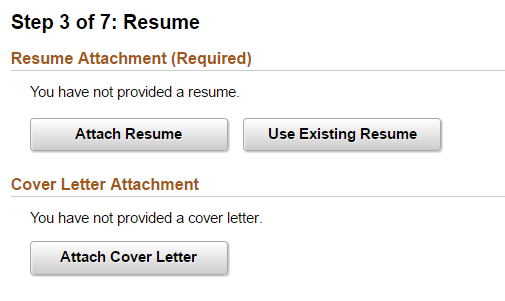
This example illustrates the Resume page after an applicant attaches a resume and a cover letter.
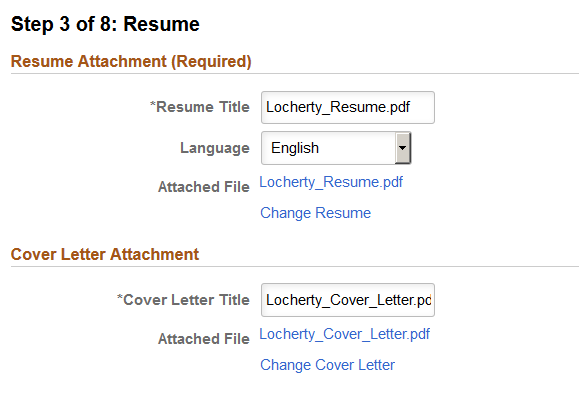
Note: If resume parsing is active, it occurs as soon as an applicant uploads a resume.
The resume template controls whether resumes and cover letters are required. If the word Required appears next to either the Resume Attachment title or the Cover Letter Attachment title, applicants cannot continue to the next step without supplying the relevant document.
Resume Attachment (Before Resume Is Provided)
The resume template controls which of the following resume options are available:
Field or Control |
Description |
|---|---|
Attach Resume |
Clicking this button displays the File Attachment dialog so that the applicant can upload an attachment. PeopleTools manages the physical storage locations of file attachments using the URL Maintenance page (PeopleTools > Utilities > Administration > URLs). Settings for the HRS_APP_ATCH_CG URL identifier determine whether there are any file type restrictions for resumes that applicants upload. The URL identifier settings also control the physical storage location for the attached file, which must match the location for the HRS_APP_ATCH URL identifier used for attachments that are uploaded in PeopleSoft Talent Acquisition Manager. |
Use Existing Resume |
Clicking this button displays the Use Existing Resume page, where applicants choose an already-submitted resume to reuse. Applicants cannot reuse resumes from unsubmitted or withdrawn applications. This button is hidden if the applicant does not have any already-submitted resumes. Applicants can view all of their submitted resumes in the Resumes grid on the My Job Applications page. |
Note: Fluid Candidate Gateway does not provide applicants with an option to copy and paste a resume into the system, even if the resume template is configured to allow this.
Resume Attachment (After Resume Is Provided)
Field or Control |
Description |
|---|---|
Resume Title |
Applicants use this field to give the resume a descriptive title. If a resume is used in more than one job application (because the applicant selected the Use Existing Resume option), a title change is reflected in all applications that use the same resume. |
Language |
Applicants use this field to select the language of their resume. This field is visible only if the Site Setup Page is configured to display the resume language. This field is informational only, so consider hiding it unless your organization has a specific use for it. |
Attached File |
Displays the file name of the resume. Clicking this link opens the file. |
Change Resume |
Clicking this link removes the current resume from the application. The Resume Attachment section returns to its initial state, displaying the resume selection buttons so that the applicant can choose a different resume. |
Cover Letter Attachment (Before Cover Letter Is Provided)
This section is visible only if the resume template is configured to include cover letters.
Field or Control |
Description |
|---|---|
Attach Cover Letter |
Clicking this button displays the File Attachment dialog so that the applicant can upload a cover letter. Applicants cannot reuse previously uploaded cover letters. |
Cover Letter Attachment (After Cover Letter Is Provided)
Field or Control |
Description |
|---|---|
Cover Letter Title |
Applicants use this field to give the cover letter a descriptive title. |
Attached File |
Displays the file name of the cover letter. Clicking this link opens the file. |
Change Cover Letter |
Clicking this link removes the current cover letter from the application. The Cover Letter Attachment section returns to its initial appearance, displaying the Attach Cover Letter button so that the applicant can choose a different document. |
Applicants use the Use Existing Resume page (HRS_RESUMES_SCF) to select a previously submitted resume to associate with the job application.
Navigation:
Click the Use Existing Resume button on the Resume page. This button is hidden if no resumes have been previously submitted.
This example illustrates the Use Existing Resume page.
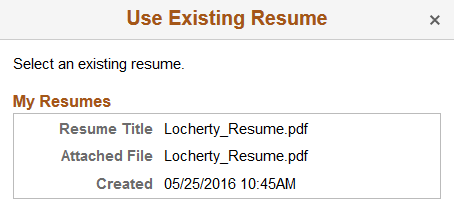
Field or Control |
Description |
|---|---|
My Resumes |
Lists all of an applicant’s previously submitted resumes. The applicant clicks a resume to use it in the current application and return to the Resume page. |
Applicants use the Copy & Paste Resume page (HRS_RES_PASTE_SCF) to view a resume that was pasted into an application.
Applicants cannot paste resumes into applications in Fluid Candidate Gateway, but they can use pasted resumes from applications that were started in classic Candidate Gateway.
Navigation:
On the Resume page, click the name of a pasted resume.
This example illustrates the Copy & Paste Resume page.
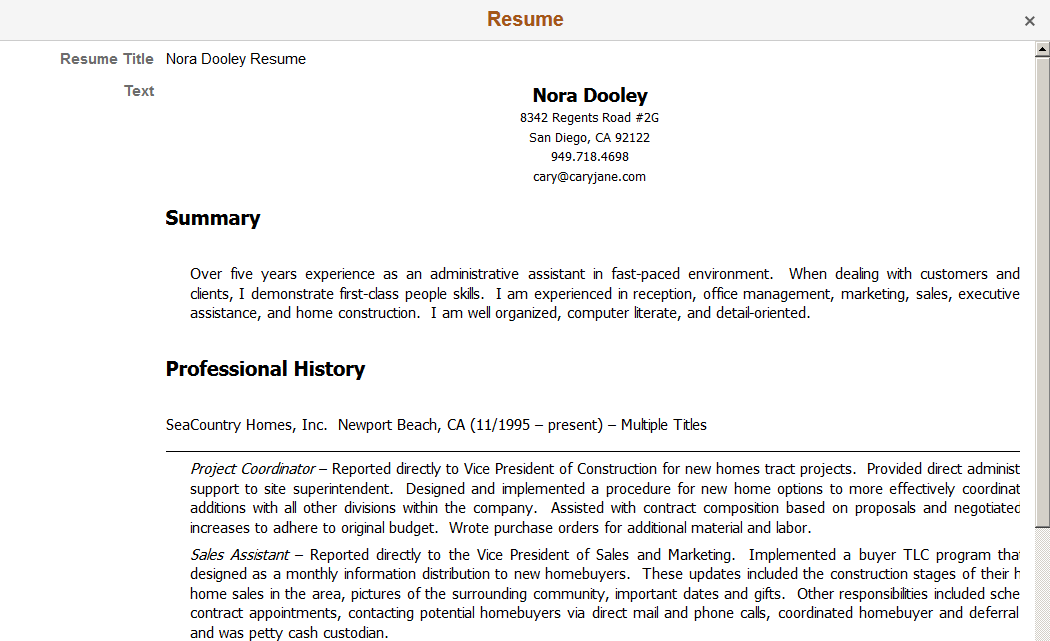
This is a read-only modal page. The applicant closes the modal to return to the application.
Applicants use the <Step Name> page (HRS_CE_PROFILE_FL) to enter additional application information. The page name corresponds to the step name that is defined in the resume template. The sections that appear on the page are those that are associated with the step in the resume template
Navigation:
Click the Next button until you reach a step that show resume template sections.
This example illustrates the <Step Name> page. This example shows the Employment Questionnaire step.

Another example illustrates the Qualifications page. This example shows a substep, so the step title includes both the step name (Qualifications) and the substep name (Experience). The step includes multiple sections from the resume template.

These are the sections that can appear on this page:
Profile-Related Sections (for example, competencies or languages)
Note: This list reflects the section order when multiple sections appear on the same step or substep. To present the sections in any other order, implementers must place the sections on separate steps and order the steps as needed. For example, if you want the Job Preferences section to appear before the Attachments section, those sections must be on different steps so that you can put the step with Job Preferences before the step with Attachments.
Note: The step where this section appears is defined in the resume template.
Applicants use the Attachments section to add attachments other than resumes and cover letters to the application.
Navigation:
In the application Activity Guide, click the Next button until you reach a step that includes the Attachments section.
This example illustrates the Attachments section.
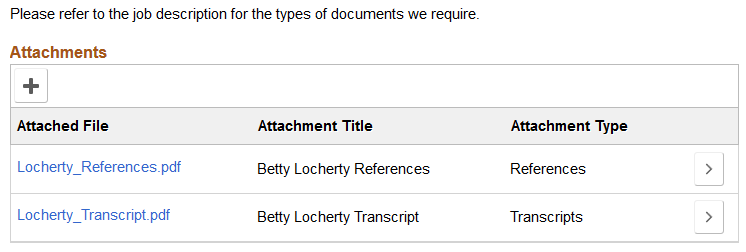
Note: This example shows instructional text before the Attachments grid. The instructional text is configured in the resume template. Note that the sample text refers applicants to the job description for more information. Fluid Candidate Gateway does not give applicants a way to review the job description while completing a job application, so this sample text is not typically appropriate for Fluid Candidate Gateway implementations.
Within the resume template, the Attachments section can be marked as required, forcing applicants to supply at least one attachment. With this configuration, it is important for your instructional text to explain what attachment(s) are required.
Field or Control |
Description |
|---|---|
|
Applicants click this button to add an attachment to the application. This button opens the Add Attachment page. |
Attached File |
Displays the file name of the attachment. Click to open the file. |
Attachment Title |
Displays a descriptive title for the attachment. |
Attachment Type |
Displays the attachment type that the applicant selected at the time the file was uploaded. |
|
Applicants click this button to open the Edit Attachment page, where they can change the attachment information, upload a different document, or delete the attachment. |
Use the Add Attachment or Edit Attachment page (HRS_CE_D_ATTCH_SCF) to enter attachment information and initiate the file upload process.
Navigation:
On a step that shows the Attachments section, click the Add or Edit button.
This example illustrates the Add Attachment page before a file has been uploaded. After a file is uploaded, it looks like the Edit Attachment page except that it does not have a Delete button.

This example illustrates the Edit Attachment page.

Fields Visible in Add Mode Before a File is Uploaded
Field or Control |
Description |
|---|---|
Attachment Type |
Applicants must select an attachment type before uploading an attachment. The available values are the attachment types where the Attachment Type Setup Page has a Max Occurrences Within a Job Application value of one or more. The system does not check whether the job application has already reached the specified maximum for the attachment type until the applicant clicks the Continue button. |
Attachment Title |
Applicants enter a descriptive name for the attached file. |
Continue |
After supplying all required information, applicants click this button to open a generic File Attachment dialog box. The options for selecting files depend on the device and on any available integrations to cloud storage. |
Fields Visible in Edit Mode and in Add Mode After a File is Uploaded
In Add Attachment mode, these fields appear after the applicant uploads a file and closes the File Attachment dialog box. These fields are always visible in Edit Attachment mode.
Field or Control |
Description |
|---|---|
Attached File |
Displays the file name of the attachment. Clicking this link opens the file. |
Use Different Attachment |
Applicants click this button to reopen the File Attachment dialog box to select and upload a new file. Before opening the File Attachment dialog, the system performs the same validations (required fields and attachment type maximums) as it does during the initial document upload. |
Done |
Applicants click this button to close the page and save the attachment to the job application. |
Cancel |
Clicking this button closes the page without updating the application. If the applicant has already uploaded a file, the uploaded file remains in the file repository for Candidate Gateway attachments, but it is not visible on any recruiting pages. |
Fields Visible Only in Edit Mode
Field or Control |
Description |
|---|---|
Delete |
Applicants click this button to remove an attachment from an application. The file remains in the file repository for Candidate Gateway attachments, but it is not visible on any recruiting pages. |
Note: The step where this section appears is defined in the resume template.
Applicants use the Job Preferences section to enter general work preferences.
Navigation:
In the application Activity Guide, click the Next button until you reach a step that includes the Job Preferences section.
This is the first of three examples illustrating the Job Preferences section.

This is the second of three examples illustrating the Job Preferences section.

This is the third of three examples illustrating the Job Preferences section.

Field or Control |
Description |
|---|---|
1. I can start my job on or after |
Applicants use this field to enter the first day that they are available to work. During screening, the system checks that this date is on or before the date in the job opening’s Desired Start Date field. |
2. I am looking for the following kind of job |
Applicants use this field to specify whether they will prefer regular work, temporary work, or either type of work. When screening based on this preference, the system checks whether the applicant prefers the type of work that is specified in the job opening’s Regular/Temporary field. The default value is Either unless the applicant selected a different value in the last saved application. |
3. I want to work the following kind of employment |
Applicants use this field to specify whether they prefer full-time work, part-time work, or either. When screening based on this preference, the system checks that the applicant prefers the type of work that is specified in the job opening’s Schedule Type field. The default value is Either unless the applicant selected a different value in the last saved application. |
4. I am willing to travel |
Applicants use this field to indicate the maximum amount of travel they will accept. When screening based on this preference, the system checks that the applicant will travel at least the amount that is specified in the job opening’s Travel Percentage field. The default value is Never or rarely unless the applicant selected a different value in the last saved application. |
5. I am willing to relocate |
Applicants use this field to indicate if they are willing to relocate. This field is not used to screen applicants. The default value is No unless the applicant selected a different value in the last saved application. |
6. I am available to work the following days of the week |
Applicants use this field to indicate which days of the week they can work. This field is not used to screen applicants. The default selections are Monday through Friday unless the applicant selected different values in the last saved application. |
7. I want to work the following shift(s) |
Applicants use this field to indicate which shifts they want to work. When screening based on this preference, the system checks that the applicant is wants to work the shift that is specified in the job opening’s Shift field. At least one option must be selected. The default value is Not Applicable. |
8. I want to work this number of hours (per week) |
Applicants use this field to indicate how many hours per week they want to work. When screening based on this preference, the system checks that the applicant wants to work at least the number hours that is specified in the job opening’s Hours field. The default value is 40 unless the applicant selected a different value in the last saved application. |
9. I require a minimum pay of |
For this question, applicants use the Amount, Currency, and Frequency fields to specify their minimum acceptable salary. When screening based on this preference, the system checks that the applicant will accept the maximum salary specified in the job opening. |
10. I would prefer a work location in or around |
Applicants use the My First Choice and My Second Choice fields to indicate their preferred work locations. Applicants can also enter free text in the Comments About Where I Prefer to Work field. The first and second choice fields are drop-down list boxes if there are up to 75 values; they are prompt fields if there are more values. The available recruiting locations are the those that are valid for the business unit(s) of the job opening(s). If the applicant applied without a job opening, the available recruiting locations are the ones associated with the default setID identified on the Site Setup Page. If the site does not have a default setID, the system uses the setID specified in the primary permission list for the user ID. (Remember, external applicants use a public access user ID to bypass signon when accessing Candidate Gateway.) If neither the site nor the primary permission list have a default setID, the location drop-downs do not show any values. When screening based on this preference, the system checks that at least one of the applicant’s choices is a valid recruiting location for the job opening. The system does not consider the relationships between recruiting locations for this purpose. For example, if the Western Region recruiting location lists the Headquarters recruiting location as one of its sub-locations, an applicant whose first choice location is Western Region is not considered a match for a job in the Headquarters region. |
Note: The step where this section appears is defined in the resume template.
Applicants use the Federal Preferences section to enter information that is specific to US Federal implementations.
Navigation:
In the application Activity Guide, click the Next button until you reach a step that includes the Federal Preferences section.
This is the first of two examples illustrating the Federal Preferences section.
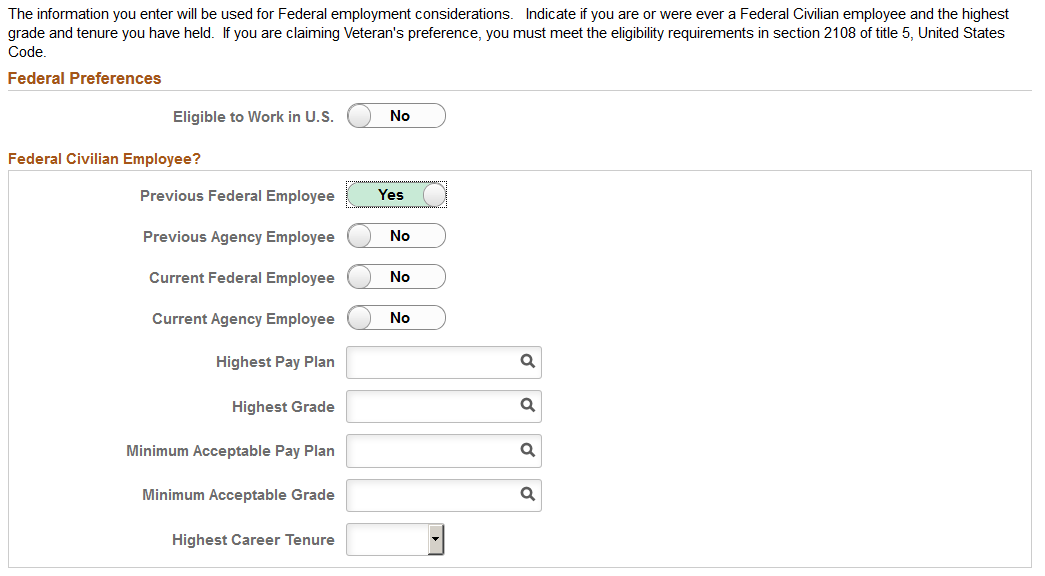
This is the second of two examples illustrating the Federal Preferences section.

Federal Preferences
The fields in the Federal Preferences section correspond to similarly-named fields in the Federal Preferences group box on the Application Details Page.
In Candidate Gateway, the following fields are visible only when the applicant selects Yes for at least one of the Yes/No questions in the Federal Civilian Employee group box (thus indicating that the applicant is a previous or current federal or agency employee):
Highest Pay Plan
Highest Grade
Minimum Acceptable Pay Plan
Minimum Acceptable Grade
Highest Career Tenure
Note: The step where this section appears is defined in the resume template.
Applicants use the Priority Placement section to provide information about their US Federal priority placement standing.
Navigation:
In the application Activity Guide, click the Next button until you reach a step that includes the Priority Placement section.
This example illustrates the Priority Placement section.

Note: Within the resume template, the Priority Placement section can be marked as required, forcing applicants to supply at least one row of data.
Priority Placement
Applicants use this section to enter their priority placement standing. The Priority Placement process uses this information, along with the salary grade and level for the job opening, to identify any applicants that have an entitlement to priority placement consideration.
See (USF) Running the Priority Placement Process.
This grid displays a summary of the applicant’s Priority Placement information. The applicant enters this information on the (USF) Add/Edit Priority Placement Page.
When the grid is empty, applicants click the Add Priority Placement button to open the Add Priority Placement page and enter information. When the grid has data, the button is an icon with a plus sign.
Applicants click an existing Priority Placement row to edit or delete it on the Edit Priority Placement page.
Applicants use the Add Priority Placement and Edit Priority Placement pages (HRS_CE_G_D_PP_SCF) to enter priority placement information.
Navigation:
On a step that shows the Priority Placement grid, click the Add button to access the page in add mode, or click an existing row to access the page in edit mode.
This example illustrates the Edit Priority Placement page. In add mode, the page title is Add Priority Placement.
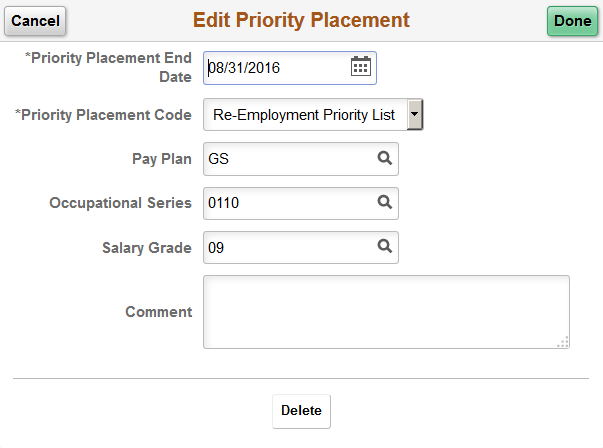
This page displays the same fields as the (USF) Priority Placement Page that Talent Acquisition Manager users access from the Application Details Page.
Note: The step where this section appears is defined in the resume template.
Applicants use the Education History section to indicate their highest level of education.
Navigation:
In the application Activity Guide, click the Next button until you reach a step that includes the Education History section.
This example illustrates the Education History section.

Education History
Field or Control |
Description |
|---|---|
Highest Education Level |
Applicants use this field to indicate their highest education level. The selected value, in conjunction with work experience data, is used during screening to determine whether the applicant has the number of years of relevant work experience that are required of applicants with the specified level of education. |
Note: The step where this section appears is defined in the resume template.
Applicants use the Work Experience section to supply information about their work history.
Navigation:
In the application Activity Guide, click the Next button until you reach a step that includes the Work Experience section.
This example illustrates the Work Experience section.

Note: Within the resume template, the Work Experience section can be marked as required, forcing applicants to supply at least one row of data.
Work Experience
This grid displays a summary of the applicant’s work experience. The applicant enters this information on the Add/Edit Work Experience Page.
For an internal applicant, the system brings in prior work experience from the employee’s Human Resources records (visible on the Prior Work Experience Page). The applicant can add or remove work experience in the application without affecting the Human Resources data.
Unlike other types of application data, work experience that an internal applicant adds in an application is not carried forward to subsequently created applications.
Adding and Editing Work Experience
When the grid is empty, applicants click the Add Work Experience button to open the Add Work Experience page and enter information. When the grid has data, the button is an icon with a plus sign.
Applicants click an existing reference to edit or delete it on the Edit Work Experience page.
Applicants use the Add Work Experience and Edit Work Experience pages (HRS_CE_D_WRK_SCF) to enter work experience details.
Navigation:
On a step that shows the Work Experience grid, click the Add button to access the page in add mode, or click an existing row to access the page in edit mode.
This is the first of two examples illustrating the Edit Work Experience page. In add mode, the page title is Add Work Experience.

Work Experience Details
The work experience fields are a subset of the fields on the Work Experience Page in Talent Acquisition Manager.
Field or Control |
Description |
|---|---|
Start Date and End Date |
These dates determine the number of years of experience represented by this entry. When the end date is blank, work experience is calculated through the current date. The Work Experience Page in Talent Acquisition Manager displays the calculated years of experience. When work experience and education are used as screening criteria, the system adds an applicant’s total years of experience across all work experience entries. That total is then compared to the amount of experience required of applicants with the specified level of education. |
Address fields (with lookup) appear as drop-down by default. However, this configuration can be changed from the framework using the Country Format setup. For more information, see Entry and Validation Page
Buttons
Field or Control |
Description |
|---|---|
Cancel |
An applicant clicks this button to close the dialog box and return to the application step without saving changes. |
Done |
An applicant clicks this button to save changes and return to the application step. |
Delete |
This button is visible only in edit mode. An applicant clicks the button to remove the row from the application. |
Note: The step where this section appears is defined in the resume template.
Applicants use the Job Training section to enter information about job training that they have received.
Navigation:
In the application Activity Guide, click the Next button until you reach a step that includes the Job Training section.
This example illustrates the Job Training section.

Note: Within the resume template, the Job Training section can be marked as required, forcing applicants to supply at least one row of data.
Job Training
This grid displays a summary of the applicant’s job training. The applicant enters this information on the Add/Edit Job Training Page.
When the grid is empty, applicants click the Add Job Training button to open the Add Job Training page and enter information. When the grid has data, the button is an icon with a plus sign.
Applicants click an existing row of job training to edit or delete it on the Edit Job Training page.
Applicants use the Add Job Training and Edit Job Training pages (HRS_CE_D_TRAIN_SCF) to enter job training details.
Navigation:
On a step that shows the Job Training grid, click the Add button to access the page in add mode, or click an existing row to access the page in edit mode.
This example illustrates the Edit Job Training Page. In add mode, the page title is Add Job Training.
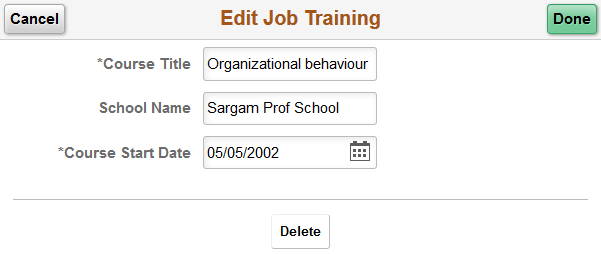
Job Training Details
Job training information consists of three fields: the Course Title, School Name, and Course Start Date.
Buttons
Field or Control |
Description |
|---|---|
Cancel |
An applicant clicks this button to close the dialog box and return to the application step without saving changes. |
Done |
An applicant clicks this button to save changes and return to the application step. |
Delete |
This button is visible only in edit mode. An applicant clicks the button to remove the row from the application. |
Note: The steps where profile-related sections appear are defined in the resume template.
Applicants use profile-related sections to enter various types of information that the system captures as profile data.
Navigation:
In the application Activity Guide, click the Next button until you reach a step that includes a profile-related section.
This example illustrates a few of the profile-related sections that can appear on resume template steps. The resume template controls which profile-related sections are included in the job application and which steps show profile-related sections.
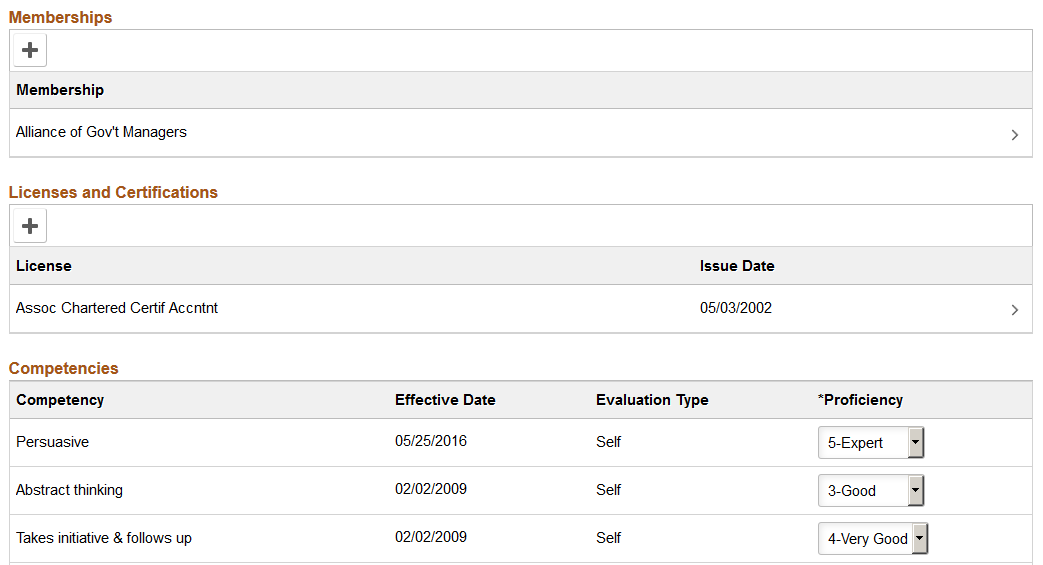
Note: Within the resume template, profile-related sections can be marked as required, forcing applicants to supply at least one row of data.
Field or Control |
Description |
|---|---|
<Content Type> |
All profile-based qualifications (such as competencies, language skills, or licenses & certificates) are rendered as grids on this page. The Content Section Configuration – <Content Type> Page in Talent Acquisition Manager controls which fields appear in the grid. It also controls whether applicants can add and delete grid rows. When adding and deleting rows is allowed, the applicant clicks the Add button or icon to create a new row and clicks an existing row to edit or delete it. When the applicant cannot add and delete rows, the grid is prepopulated with items that are associated with the job opening, and specific grid columns become editable so that the applicant can provide the necessary information. The Competencies grid is delivered with this configuration as shown in the page illustration. Note: If an applicant cannot add items to a grid and the job openings does not have any items to load into the grid, the section is hidden. If the hidden grid is the only section on a step or substep, the entire step or substep is removed from the application. |
Applicants use the Add <Profile Content Type> page and the Edit <Profile Content Type> pages (HRS_CE_D_JPM_A_SCF) to enter profile information.
Navigation:
On a page that shows a profile-related grid, click the Add button to access the page in add mode, or click an existing row to access the page in edit mode.
This example illustrates the Edit <Profile Content Type> page for the language skills content type. In add mode, the age title is Add <Profile Content Type>.
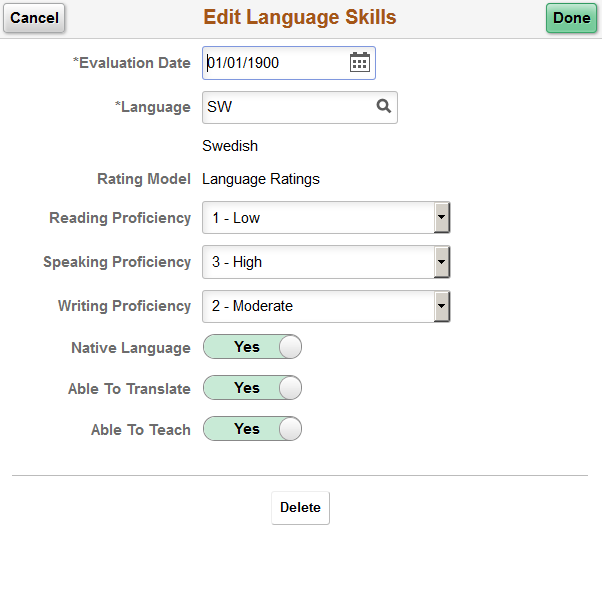
Page Title and Fields
All of the profile-based qualifications use the same detail pages, but the page title and content vary according to the specific qualification. For example, when an applicant accesses the page from the Language Skills grid, the title includes the label Language Skills, and the page displays fields that have been defined as part of the Language Skills profile content type.
Although profile configuration determines the fields that are part of each content type and the valid values for prompt fields, settings on the Content Section Configuration – <Content Type> Page page in Talent Acquisition Manager control which fields applicants can see on this detail page.
Effective-Dated Key Fields for Content Items
The detail page where applicants enter a content item always includes a field for the content item identifier (for example, the language code or the competency code). The values for this field are controlled by an effective date. The label for the effective date can vary.
For example, in the illustration above, the effective date field is labeled Evaluation Date. The valid values for the Language field are the language codes that are active as of the specified date.
Buttons
Field or Control |
Description |
|---|---|
Cancel |
An applicant clicks this button to close the dialog box and return to the application step without saving changes. |
Done |
An applicant clicks this button to save changes and return to the application step. |
Delete |
This button is visible only in edit mode. An applicant clicks the button to remove the row from the application. |
Applicants use the References section to supply the names of people who can provide personal or professional references.
Note: The step where this section appears is defined in the resume template.
Navigation:
In the application Activity Guide, click the Next button until you reach a step that includes the References section.
This example illustrates the References section.

Note: Within the resume template, the References section can be marked as required, forcing applicants to supply at least one row of data.
References
This grid displays a summary of the applicant’s references. The applicant enters this information on the Add/Edit Reference Page.
When the grid is empty, applicants click the Add References button to open the Add Reference page and enter reference information. When the grid has data, the button is an icon with a plus sign.
Applicants click an existing reference to edit or delete it on the Edit References page.
Applicants use the Add Reference and Edit Reference pages (HRS_CE_D_REFS_SCF) to enter name and contact details for a reference.
Navigation:
On a step that shows the References grid, click the Add button to access the page in add mode, or click an existing row to access the page in edit mode.
The References grid can appear in two places: on an application step, and on the Applicant References Page. Applicants access the Applicant References page from the Candidate Gateway notification that is generated when a Talent Acquisition Manager user sends a request for references. The request for references is triggered from the Create Applicant Page: References Tab.
This example illustrates the Edit Reference page. In add mode, the page title is Add Reference.
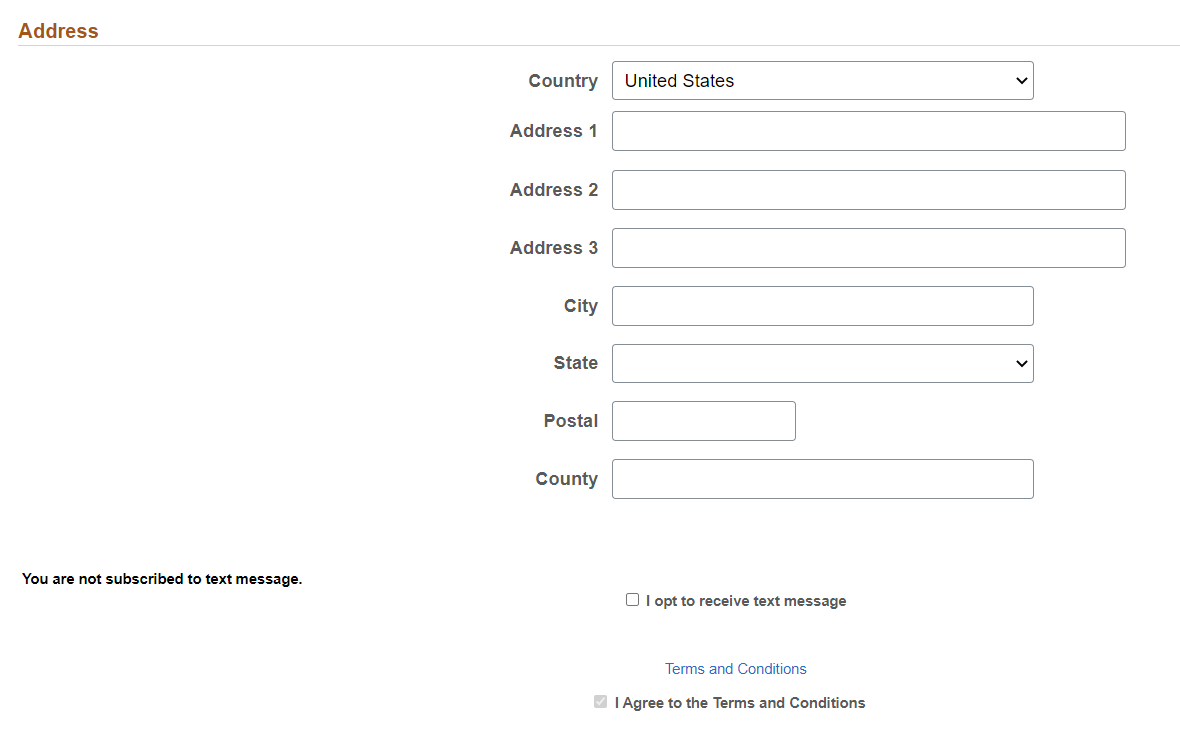
Applicants use this page to supply name and contact information for people who can provide professional or personal references.
Address fields (with lookup) appear as drop-down by default. However, this configuration can be changed from the framework using the Country Format setup. For more information, see Entry and Validation Page
Buttons
Field or Control |
Description |
|---|---|
Cancel |
An applicant clicks this button to close the dialog box and return to the application step without saving changes. |
Done |
An applicant clicks this button to save changes and return to the application step. |
Delete |
This button is visible only in edit mode. An applicant clicks the button to remove the row from the application. |
Note: The step where this section appears is defined in the resume template.
Applicants use the Personal Information section to enter marital status, birth date, and gender information.
Navigation:
In the application Activity Guide, click the Next button until you reach a step that includes the Personal Information section.
This example illustrates the Personal Information section.

A resume template that includes the Personal Information section also specifies which of the three personal information fields to display: Marital Status, Date of Birth, and Gender.
The applicant’s gender is stored in the same record regardless of whether it is collected in the Personal Information section or on the (USA) Diversity Page. Changes to the data on one page are reflected on the other page as well.
Note: The step where this section appears is defined in the resume template.
Applicants use the Questionnaire section to answer questions.
Navigation:
In the application Activity Guide, click the Next button until you reach a step that includes the Questionnaire section.
This example illustrates the Questionnaire section.
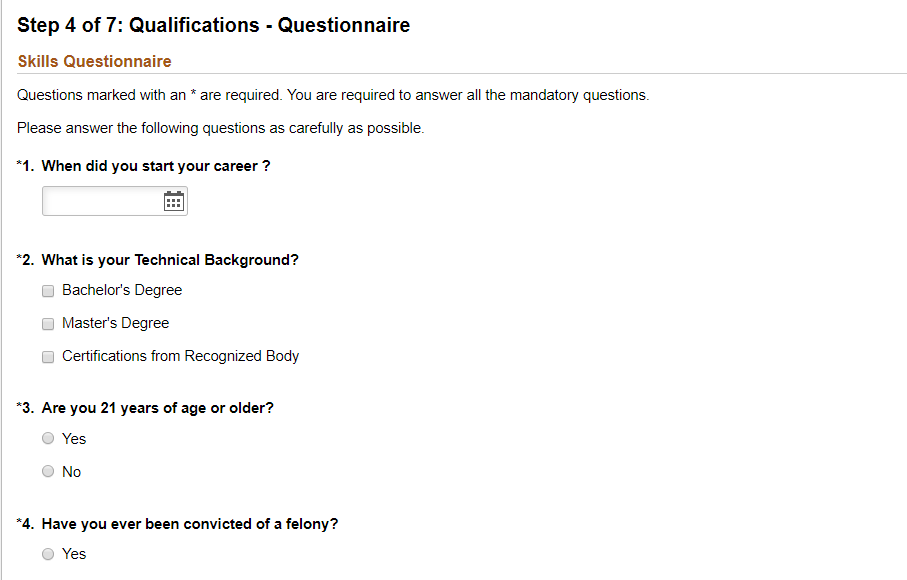
Note: If the job openings do not have any questions other than prescreening questions, the Questionnaire section is hidden. If the Questionnaire section is hidden when it is the only section on a step or substep, the entire step or substep is removed from the application.
Field or Control |
Description |
|---|---|
Questionnaire |
Displays a numbered list of Skills and/or Employment questions. The list includes all questions from the job opening except for questions that were used for prescreening. In a multi-job application, questions for all jobs are consolidated into one list. Radio buttons indicate that a question has one correct answer. Check boxes indicate that a question has multiple correct answers. An option on the Recruiting Installation – Jobs Page page control whether questions appear in a random order or in the order specified on the job opening(s). An additional installation setting controls whether answers appear in random order or in the order specified in the question definition. |
Word Count |
An applicant clicks this button, which appears under each open-ended question, to obtain the current word count for the answer. The word count appears in the Total Words field. |
Note: If the Require Answers to Questions check box on the Site Setup Page is selected, the section titles include the word (Required), and applicants must supply answers to all questions before continuing.
Applicants use the Referrals section to indicate how they learned of the job opening
Note: The step where this section appears is defined in the resume template.
Navigation:
In the application Activity Guide, click the Next button until you reach a step that includes the Referrals section.
This example illustrates the Referrals section. In this example, the applicant was referred by an employee, so several employee-specific fields are visible.
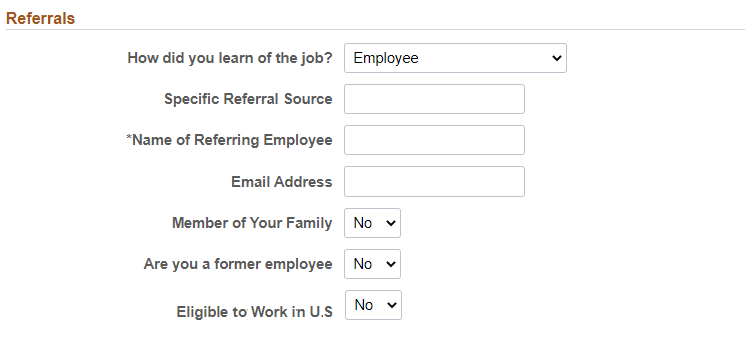
Field or Control |
Description |
|---|---|
How did you learn of the job? |
Applicants use this field to select a referral source. The available values are recruitment sources where the source type is Marketing or Employee. For information about recruitment sources, see Setting Up Recruitment Sources. If the applicant selects an employee recruitment source, several additional fields appear. This field is required if the resume template is configured to require applicants to enter a referral source. |
Additional Information |
This field appears only if the referral source is a marketing recruitment source for which subsources have been defined. Applicants use the field to select from the list of predefined subsources. A resume template that requires applicants to enter a referral source can also require applicants to enter a subsource. If the selected source does not have any subsources, this requirement is ignored. |
Specific Referral Source |
Applicants use this field to enter freeform text with additional information about the referral source. |
Name of Referring Employee |
This field appears only if the referral source is an employee recruitment source. Applicants are required to enter the name of the referring employee. Recruiters use this information when looking up the employee ID of the referring employee. |
Email Address |
This field appears only if the referral source is an employee recruitment source. Applicants use this field to enter the email address of the referring employee. The system uses this email address to send the referring employee a notification requesting verification of the referral. Only verified referrals are eligible for awards under an employee referral program. |
Member of your Family |
This field appears only if the referral source is an employee recruitment source. Applicants use this field to indicate whether the referring employee is a family member. Depending on an employee referral program’s rules, family member referrals may not be eligible for referral awards. |
Eligible to Work in U.S |
Applicants use this field to indicate whether they are eligible to work in the U.S. By default, the value is given as ‘No’. Note: Default Value is No for "Eligible To Work in US" if it is set as Non-Required in Resume Template. If it is set as "Required" in Resume Template and this is the first application of applicant then this field will be blank by default and applicant will have to manually choose Yes or No. |
Are you a former employee |
Applicants use this field to indicate whether they are former employees. This information is of interest to recruiters. It can also affect a referring employee’s eligibility for a referral award. If the applicant selects ‘Yes’, the field to enter the last day of employment is displayed. Note: Default Value is No for "Are you a former employee" if it is set as Non-Required in Resume Template. If it is set as "Required" in Resume Template and this is the first application of applicant then this field will be blank by default and applicant will have to manually choose Yes or No. |
Last Day of Employment |
If the applicant is a former employee, it is required to provide the last day of employment. |
Note: Information provided in the Referrals step will appear in the “Review and Submit Step” and “View Submitted Applications”.
Applicants use the Community Background page (HRS_APP_CB2_FL) to enter community background information for Northern Ireland.
Note: The Community Background page appears only if it is activated in the resume template.
Navigation:
In application Activity Guide, click the Next button until you reach this step.
This example illustrates the Community Background Page.

Applicants cannot continue to the next step without supplying community background information.
If an applicant supplies information and then exits the application without submitting, community background information is not saved. When resuming the application, the applicant is returned to this step and must enter community background data again before continuing.
Field or Control |
Description |
|---|---|
Community |
Applicants must supply select Catholic, Protestant, or Undetermined/Other before continuing to the next step in the application. |
External applicants use the Disability page (HRS_CE_DISABILI_FL) to optionally enter disability information. Internal applicants do not see this page. This page supports compliance with OFCCP regulations from the U.S. Department of Labor.
Navigation:
In the application Activity Guide, click the Next button until you reach this step. This page appears only if all of these conditions are met:
The OFCCP Self-Identify field on the Site Setup Page is either Disability and Veteran or Disability.
The applicant is external.
The job opening is in the USA, or if the application does not have a job opening, the applicant’s address is in the USA.
An example illustrating the Disability page.

Note: The text on this page comes from the Text Catalog. If the OFCCP changes the required wording for disability self-identification, update the relevant Text Catalog entries.
If an applicant supplies information and then exits the application without submitting, disability information is not saved. When resuming the application, the applicant is returned to this step and must enter the information again before continuing.
Field or Control |
Description |
|---|---|
Please check one of the boxes below |
The applicant can optionally select from the three choices given. There is no default selection, even if the applicant has previously selected an option. The explanatory text on the page provides the applicant with information to help make a choice. An applicant who chooses not to answer can click the Next button to move to the next page without selecting any of the boxes. If the applicant does not answer, or chooses the I do not want to answer option, the system does not update the applicant’s existing disability data. Otherwise, the system updates the applicant’s Section 503 data in the Applicant Disability group on the Eligibility & Identity tab of the Manage Applicant page: Applicant Data Tab. |
Name and Date |
The system enters the applicant’s name and the current date in these read-only fields. They represent the applicant’s electronic signature. The signature and date are not displayed on the Eligibility & Identify section of the Manage Applicant page: Applicant Data tab, but they are stored in the PS_HRS_APP_DIS record. If a recruiting user updates the applicant’s disability information on the Manage Applicant page, the system clears the stored name from the HR_EE_SIGNATURE field. The system also updates the HRS_ROW_UPD_OPRID field with the user ID of the user who made the update. |
External applicants use the Veteran page (HRS_CE_VETERAN_FL) to optionally enter veteran information. Internal applicants do not see this page.
This page supports compliance with OFCCP regulations from the U.S. Department of Labor.
Navigation:
In the application Activity Guide, click the Next button until you reach this step. This page appears only if all of these conditions are met:
The OFCCP Self-Identify field on the Site Setup Page is either Disability and Veteran or Veteran.
The applicant is external.
If the application includes job openings, at least one job opening is in the USA; if the application does not have a job opening, the applicant’s address is in the USA.
Note: There are two versions of the Veteran page, a standard version and a simplified version. Settings on the Site Setup page determine which version appears.
This is the first of two examples illustrating the standard version of the Veteran page.

This is the second of two examples illustrating the standard version of the Veteran page.
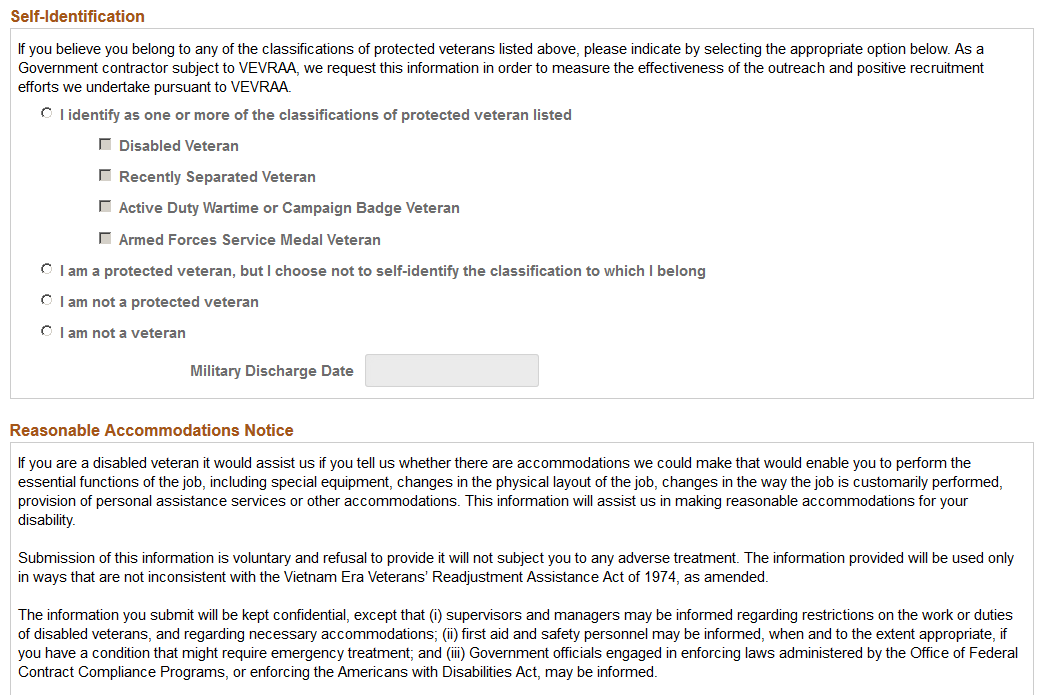
This example illustrates the Self-Identification section on the simplified Veteran page. The rest of the simplified Veteran page is identical to the standard version of the page.

The text on both versions of the Veteran page comes from the Text Catalog. If the OFCCP changes the required wording for veteran self-identification, update the relevant Text Catalog entries.
If an applicant supplies information and then exits the application without submitting, veteran information is not saved. When resuming the application, the applicant is returned to this step and must enter the information again before continuing.
Self-Identification
Self-identification options depend on whether the site is configured to show the regular or simplified version of the Veteran page.
The regular version of this page includes a full set of self-identification options and a Military Discharge Date field.
Selecting the “I identify as one or more of the classifications of protected veteran listed” radio button causes four check boxes representing specific classifications become enterable. The applicant must select at least one of the specific classifications.
The Military Discharge Date field is enterable if the applicant selects any option except the “I am not a veteran” option.
The simplified version of this page offers only two self-identification options: protected veteran or not a protected veteran. Applicants cannot select specific classifications, nor can they enter a military discharge date.
For both versions of the page, the explanatory text under the Definitions heading provides the applicant with information to help make a choice. Data from previous applications appears on this page by default.
Reasonable Accommodations Notice and Custom Text
Organizations can add their own additional text (such as affirmative action program text) below the Reasonable Accommodations Notice section on this page. Add this text in Text Catalog entry HRAM_FL_VET_INSTR4, which is shipped empty as a placeholder.
This example shows the layout of the Reasonable Accommodations Notice text with the space reserved for custom text. In this example, Text Catalog IDs appear instead of the text from the catalog.

Corresponding Fields in Talent Acquisition Manager
An applicant’s veteran information is visible in Talent Acquisition Manager on the Manage Applicant page: Applicant Data tab.
The system automatically maps veteran self-identification data from Candidate Gateway into these Eligibility & Identity fields:
In the Veteran group box in the main USA section of the Eligibility & Identity page:
The Military Status field displays the applicant’s overall military status.
The Disabled Veteran check box indicates whether the applicant is a disabled veteran in addition to any other military status shown.
In the Veteran group box in the USA Disability section of the Eligibility & Identity page, the Military Discharge Date shows when the applicant left the military.
Mapping Simplified Self-Identification Options to Talent Acquisition Manager
The following table shows how options on the simplified Veteran page in Candidate Gateway map to Talent Acquisition Manager:
|
Veteran Option in Candidate Gateway |
Talent Acquisition Manager Fields |
|---|---|
|
I identify as one or more of the classifications of protected veteran listed |
Military Status is Protected, Not Classified. |
|
I am not a protected veteran |
Military Status is Not a Protected Veteran. |
Mapping Regular Self-Identification Options to Talent Acquisition Manager
The following table shows how options on the regular Veteran page in Candidate Gateway map to Talent Acquisition Manager:
|
Veteran Option in Candidate Gateway |
Talent Acquisition Manager Fields |
|---|---|
|
I identify as one or more of the classifications of protected veteran listed |
|
|
I am a protected veteran, but I choose not to self-identify the classification to which I belong. |
Military Status is Protected, Not Classified. |
|
I am not a protected veteran |
Military Status is Not a Protected Veteran. |
|
I am not a veteran. |
Military Status is Not a Veteran. |
|
Military Discharge Date |
Military Discharge Date shows the same value that was entered in Candidate Gateway. |
Detailed Mapping for Protected Veteran Classifications
The following table lists how the four protected veteran classifications in Candidate Gateway map to Military Status values in Talent Acquisition Manager:
|
Candidate Gateway Classification Check Box(es) |
Talent Acquisition Manager Military Status |
|---|---|
|
Disabled Veteran |
Protected, Not Classified |
|
Recently Separated Veteran |
Recently Separated Veteran |
|
Active Duty Wartime or Campaign Badge Veteran |
Active Duty/Campaign Badge Vet |
|
Armed Forces Service Medal Veteran |
Armed Forces Service Medal Vet |
|
Multiple values:
|
Separated & Active Duty Vet |
|
Multiple values:
|
Separated & Service Medal Vet |
|
Multiple values:
|
Service Medal & Active Duty |
|
Multiple values:
|
Separated/Srvc Medal/Active |
|
Multiple values:
|
Based on the selected check boxes other than the Disabled Veteran check box. When used in combination with other classifications, the Disabled Veteran check box does not affect the Military Status field. When the Disabled Veteran check box is the only selected check box, the Military Status is Protected, Not Classified. |
External applicants use the Diversity page (HRS_CE_SELF_IDE_FL) to enter gender and ethnicity information for equal employment opportunity reporting in the United States. Internal applicants do not see this page.
Navigation:
In the application Activity Guide, click the Next button until you reach this step. This page appears only if both of these conditions are met:
The applicant is external.
The job opening is in the USA, or if the application does not have a job opening, the applicant’s address is in the USA.
This example illustrates the Diversity page when the system is configured to use two questions to collect ethnicity and race information. In this example, the application includes multiple self-identification pages, so the page title indicates that the Diversity page is a substep of the Self-Identify step.
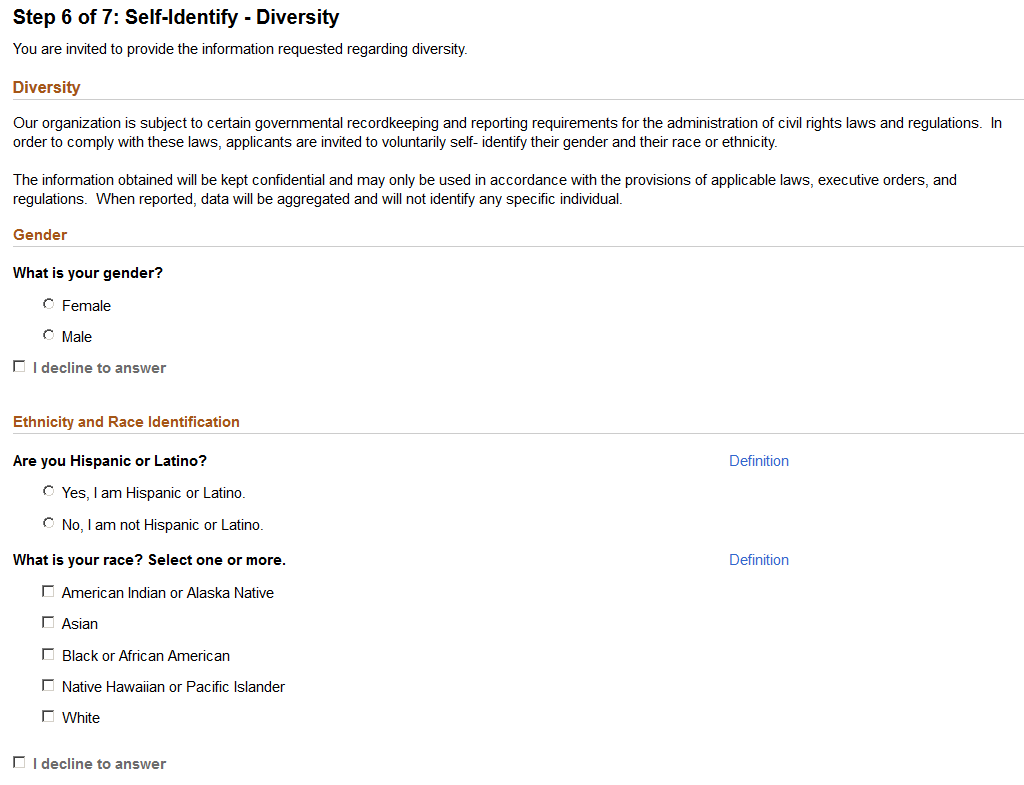
This example illustrates the Diversity page when the system is not configured to use the two-question format to collect ethnicity data. In this example, the Diversity page is the only self-identification page in the application, so the page title is used as the full step title.
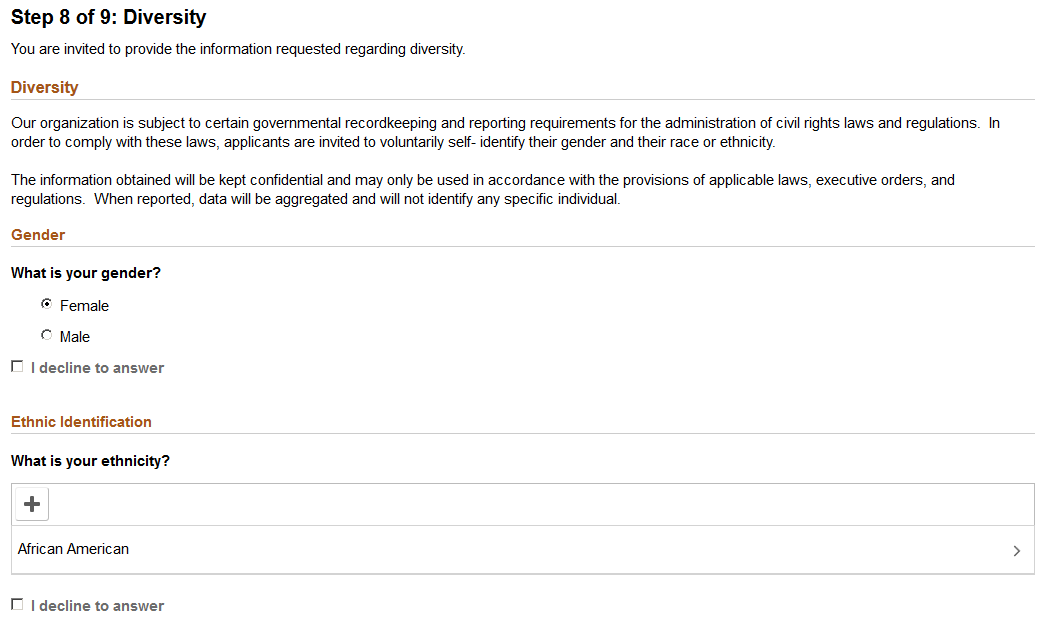
Applicants cannot continue to the next step without either supplying diversity information or explicitly declining to answer questions. Applicants can provide one type of information while still declining to provide the other.
Default answers, if any, come from the applicant record. The applicant record is updated when the applicant submits an application.
If an applicant supplies information and then exits the application without submitting, changes made on this page are not saved. When resuming the application, the applicant is returned to this step and the default values reappear.
Gender
Field or Control |
Description |
|---|---|
Gender |
The applicant selects a radio button to answer Female or Male. The applicant’s gender is stored in the same record regardless of whether it is collected in the Personal Information Section or on this page. Changes to the data on one page are reflected on the other page as well. |
I decline to answer |
Applicants select this check box if they do not want to identify themselves as female or male. If this check box is not selected, the applicant must select one of the gender options before continuing to the next step. Selecting this check box clears any previous gender selection and makes the Gender radio buttons read-only. Subsequently deselecting the check box does not restore any previous selection. |
Ethnicity and Race Identification
If the Two-Question Format (Ethnicity) check box is selected on the Country Specific Page, the following fields are used to collect ethnicity and race information.
Field or Control |
Description |
|---|---|
1. Are you Hispanic or Latino? |
The applicant selects a radio button to answer Yes or No. |
2. What is your race? Select one or more. |
The applicant selects one or more of these check boxes:
|
I decline to answer |
Applicants select this check box if they do not want to answer either of the ethnicity and race questions. If this check box is not selected, the applicant must answer at least one of the ethnicity and race questions before continuing to the next step. Selecting this check box clears any answers that were previously supplied for the ethnicity and race questions and makes those questions read-only. Subsequently deselecting the check box does not restore any previous answers. |
Note: The two-question format is not valid for US Federal implementations.
Ethnic Identification
If the Two-Question Format (Ethnicity) check box is not selected on the Country Specific Page, the following fields are used to collect ethnic group information:
Field or Control |
Description |
|---|---|
|
When the grid is empty, applicants click the Add Ethnic button to open the Add Ethnic Group page and enter information. When the grid has data, the button is an icon with a plus sign. |
What is your ethnicity? |
This grid lists the applicant’s ethnic groups. Applicants click an ethnic group to access the Edit Ethnic Group page. |
I decline to answer |
Applicants select this check box if they do not want provide ethnic group information. If this check box is not selected, the applicant must add at least one ethnic group before continuing to the next step. Selecting this check box removes all ethnic groups from the grid and disables the Add Ethnic Group button. Subsequently clearing the check box does not restore any previous data. |
Applicants use the Add Ethnic Group and Edit Ethnic Group pages (HRS_CE_D_DIV_SCF) to enter job training details.
Navigation:
On the Diversity page, click the Add button to access the page in add mode, or click an existing row to access the page in edit mode.
This example illustrates the Edit Ethnic Group Page. In add mode, the page title is Add Ethnic Group.

Field or Control |
Description |
|---|---|
Ethnic Group |
Applicants use this field to select an ethnic group to which they belong. Ethnic groups are defined on the Ethnic Groups Page. The list of ethnic groups is based on the regulatory region that is associated with the primary permission list for the user ID that was used to access the page. Remember that external applicants access the system using a public access user ID that bypasses the PeopleSoft sign in page. The primary permission list for a user ID is established in the User Profile component in PeopleTools. The regulatory region for the primary permission list is established on the Org Defaults by Permission Lst - Defaults Page. On the Regulatory Region Page, you can view the setID that controls which ethnic groups are valid for the regulatory region. |
Buttons
Field or Control |
Description |
|---|---|
Cancel |
An applicant clicks this button to close the dialog box and return to the Diversity page without saving changes. |
Done |
An applicant clicks this button to save changes and return to the Diversity page. |
Delete |
This button is visible only in edit mode. An applicant clicks the button to remove the row from the application. |
Applicants use the Review and Submit page (HRS_CE_REVIEW_FL) to review application data and to submit an application.
Navigation:
In the application Activity Guide, click the Next button until you reach this step. Review and Submit is always the final step in the application process.
This is the first of eight examples illustrating the Review and Submit page.
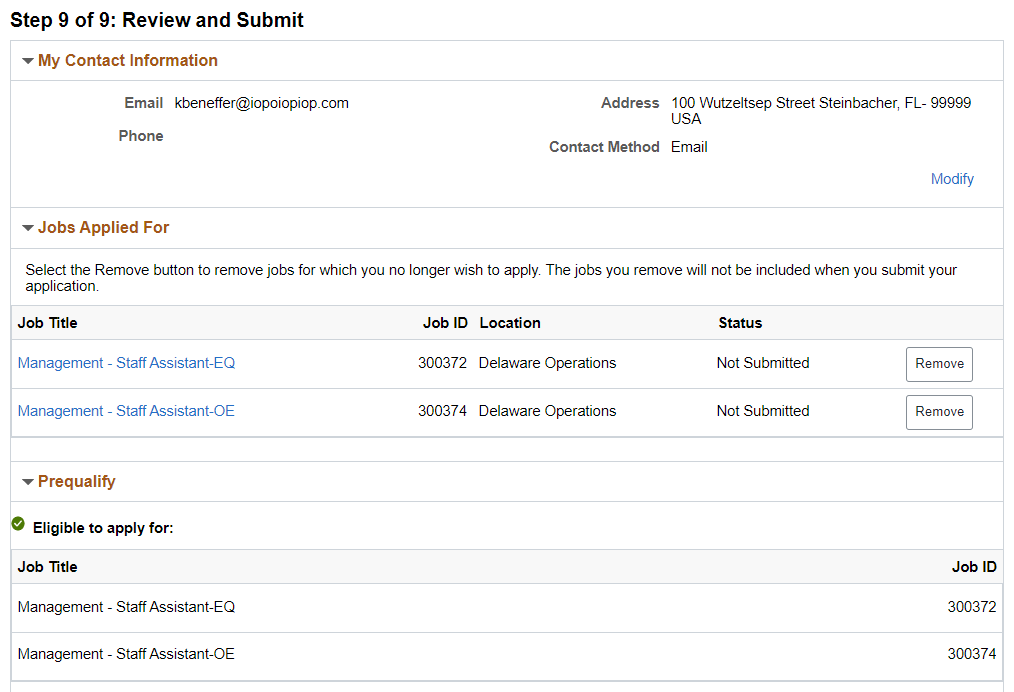
This is the second of eight examples illustrating the Review and Submit page.
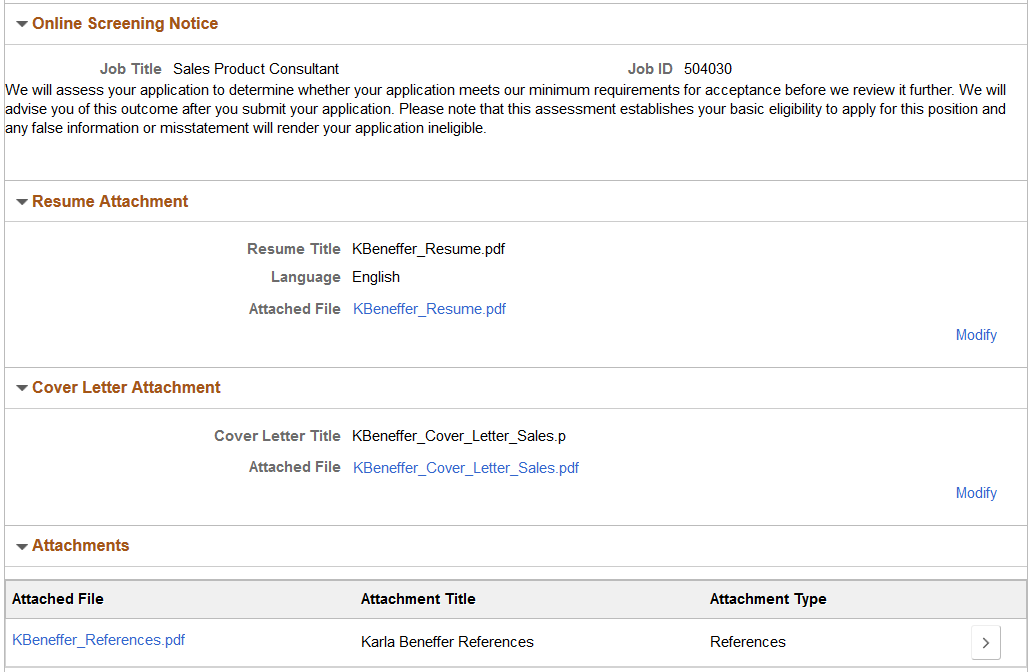
This is the third of eight examples illustrating the Review and Submit page.
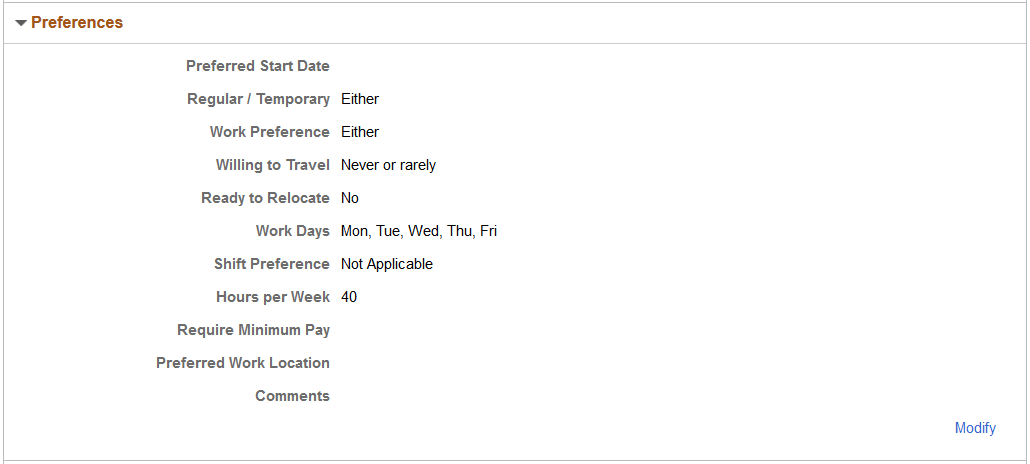
This is the fourth of eight examples illustrating the Review and Submit page.
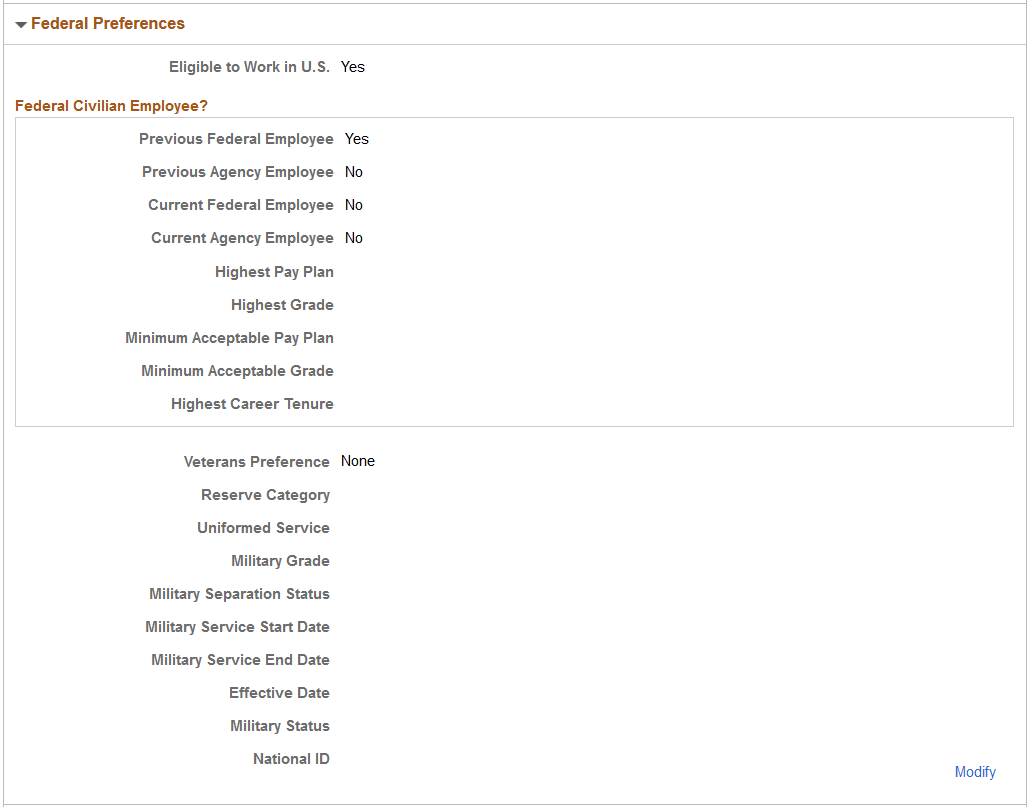
This is the fifth of eight examples illustrating the Review and Submit page.
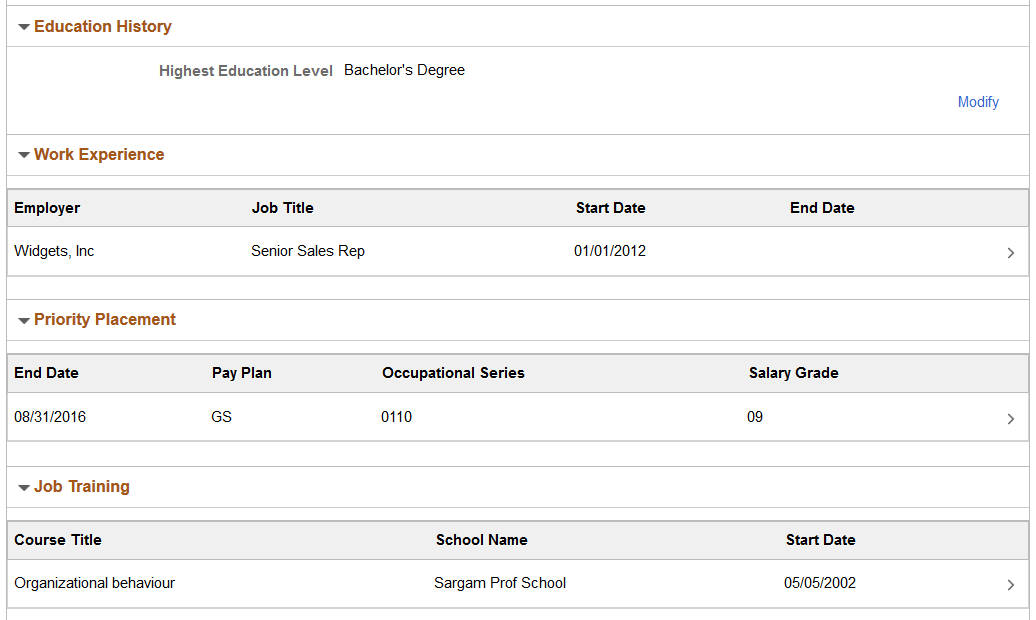
This is the sixth of eight examples illustrating the Review and Submit page.
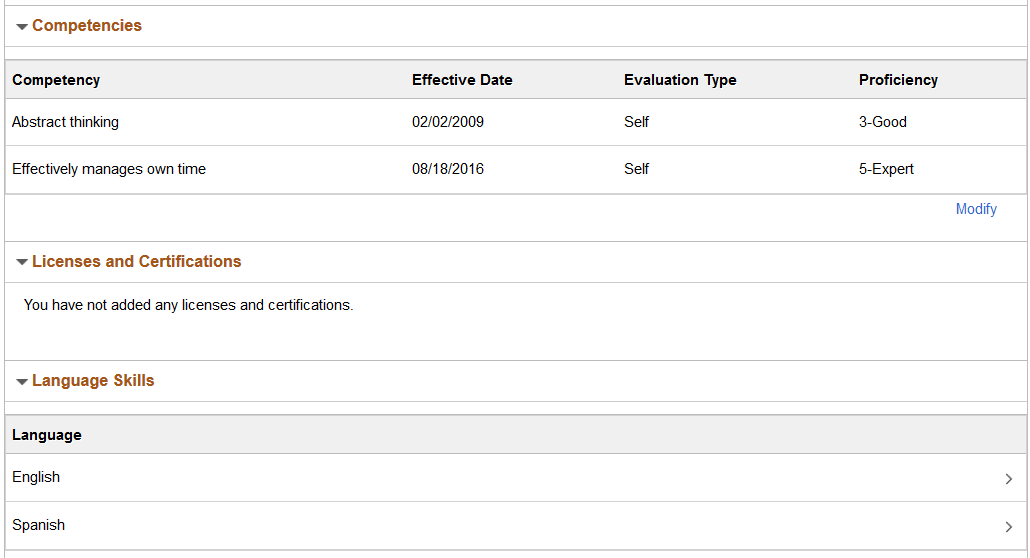
This is the seventh of eight examples illustrating the Review and Submit page.

This is the eighth of eight examples illustrating the Review and Submit page. In this example:
The Veteran section corresponds to the simplified version of the Veteran page. Additional information appears for the non-simplified version, including any protected classifications and any military discharge date that the applicant supplied.
The Diversity section corresponds to the two-question format for ethnicity and race.
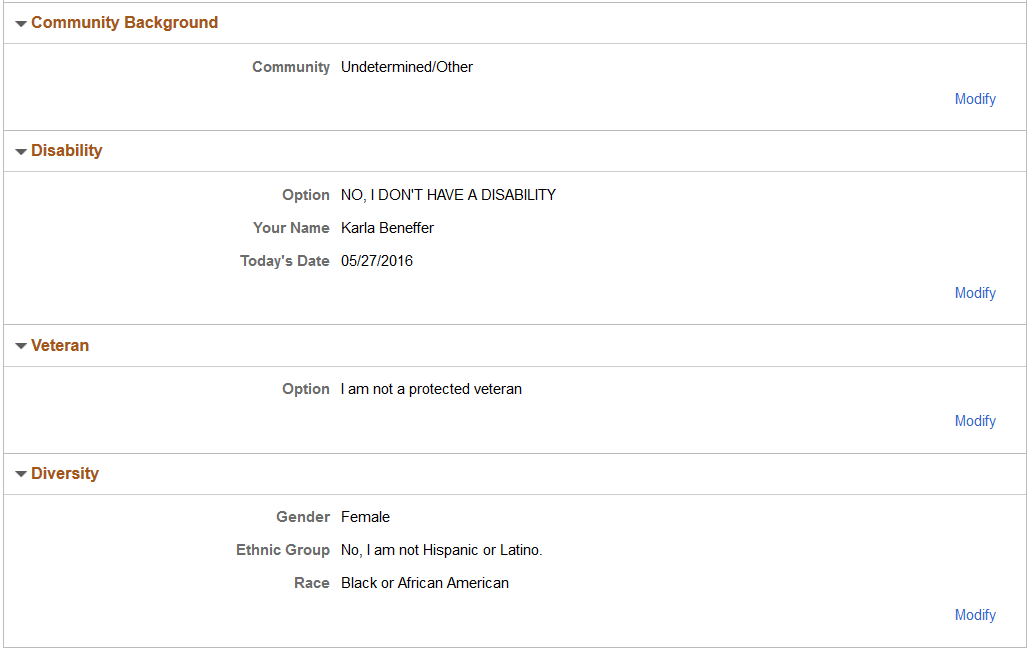
The Review and Submit step provides a read-only summary of application data.
Buttons
Field or Control |
Description |
|---|---|
Submit |
On the Review and Submit page, the Submit button replaces the Next button. When the applicant clicks the Submit button, the system performs online screening, if applicable, then displays the Application Confirmation page. Applicants cannot make any further changes to an application that has been submitted. To provide an updated application, the applicant must re-apply. Applications that have been submitted have the status Submitted in the Applications grid on the My Job Applications page. If the job opening is no longer open at the time the user attempts to submit the application, an error message informs the user that the job is no longer available and that the application cannot be submitted. |
General-Purpose Sections
Field or Control |
Description |
|---|---|
My Contact Information |
Contact information is general to the applicant (and not specific to an individual application), but the Review and Submit page displays contact information so that the applicant can verify the data. Clicking the Modify link opens the My Contact Information Page in a modal window where external applicants can update their contact information. Contact information for internal applicants comes from the HR system and cannot be updated in Candidate Gateway. |
Jobs Applied For |
This section appears only for multi-job applications. It lists the jobs that are included in the application and provides a delete option so that the applicant can remove jobs. Removing a job from an application is not reversible. This list does not include jobs that were removed from the application because the applicant failed prescreening. Click the Job Title link to access the Job Description page. |
Prequalify |
The Prequalify section appears only if the application included prescreening. This section always lists the jobs that the applicant is eligible to apply for. They appear under the heading Eligible to apply for. If any jobs were removed from the application because the applicant failed prescreening, this section lists those jobs under the heading Not eligible to apply for. |
Online Screening Notice |
This section appears only if online screening is active and if the online screening definition includes an Explain Text ID for an online screening notice. The notice appears after the relevant job title and job ID. If the application includes multiple jobs with online screening, the notices for jobs that use the same Explain Text ID are consolidated. That is, the titles and job IDs for all jobs using a particular notice are listed before the notice. If jobs use different Explain Text IDs, the notices appear sequentially under the appropriate job titles and IDs. |
Summary of Application Data
The following sections display read-only summaries of the application data:
Resume Attachment
Cover Letter Attachment
Attachments
Preferences
(USF) Federal Preferences
Education History
Work Experience
Job Training
(USF) Priority Placement
<Profile Sections>
References
Personal Information
Referrals
Community Background
Disability
Veteran
The format for the Veteran section depends on whether you collect information using the regular form or simplified form.
Diversity
The format for the Diversity section depends on whether you collect ethnicity information using the two-question format or a single list of ethnic groups.
Note: The Review and Submit page does not display questionnaire data.
Modifying Data
Applicants have several ways to modify information:
Click a step in the Activity Guide step list to return to that step.
For sections where applicants entered data directly on the step page, a Modify link in the corresponding Review and Submit section returns the applicant to the relevant step or substep.
Sections with a Modify link include Resume Attachment, Cover Letter Attachment, Attachments, Preferences, Federal Preferences, Education History, Personal Information, Referrals, Community Background, Disability, Veteran, and Diversity. The Modify link is also available for profile-related sections such as competencies where the applicant originally entered data on the main step page.
For sections where applicants entered data on a modal detail page, tapping an individual row of data item opens the modal detail page so that the applicant can make changes without leaving the Review and Submit step. If no data is present, a Modify link appears instead, and applicants can click that link to return to the step and add data.
This option is available for existing rows in the grids for Work Experience, Priority Placement, Job Training, References, and most profile-related sections. It does not work for profile-related sections such as competencies where the applicant originally entered data on the main step page.
External applicants use the My Contact Information page (HRS_PRFILEINFO_SCF) page to review and update name and contact information before submitting an application.
Internal applicants use this page to review name and contact information, but they cannot change this data because it comes from HR records. The only change an internal applicant can make is to the contact method.
Navigation:
Click the Modify link in the My Contact Information section of the Review and Submit page.
This example illustrates the My Contact Information page. This is a partial illustration that does not show the email and phone sections of the page.
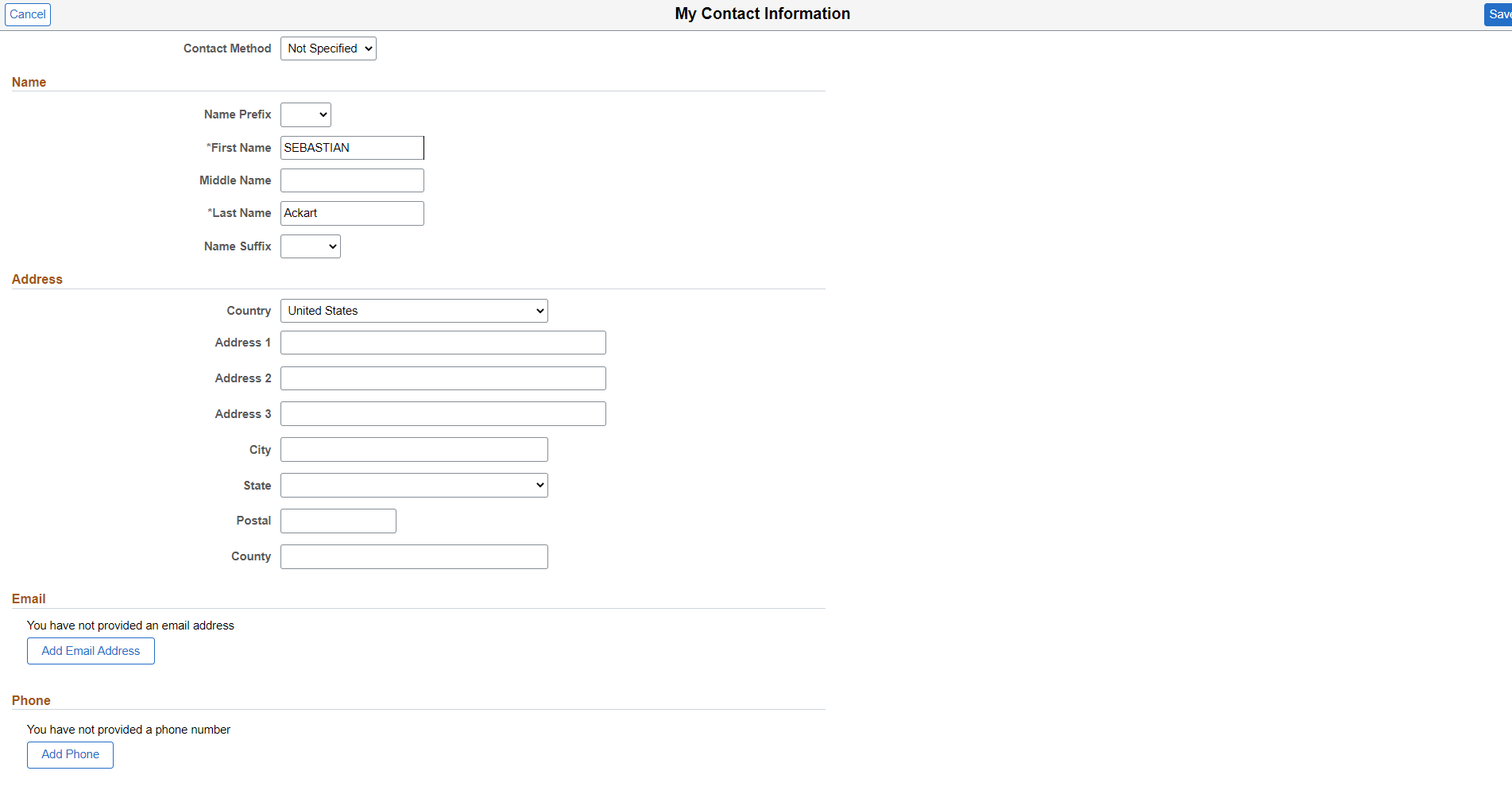
Address fields (with lookup) appear as drop-down by default. However, this configuration can be changed from the framework using the Country Format setup. For more information, see Entry and Validation Page
For internal users, this page is identical to the My Contact Information Page.
For external users, this page displays the same contact information as the My Account Information Page. However, unlike the My Account Information page, this page does not display information related to the user name and password.
Applicants use the Application Confirmation page (HRS_CE_CONFIRM_FL) to:
Receive confirmation that an application has been successfully submitted.
Review online screening results for job openings that include results messages for online screening.
Navigation:
Click the Submit button on the Review and Submit page.
This example illustrates the Application Confirmation page.
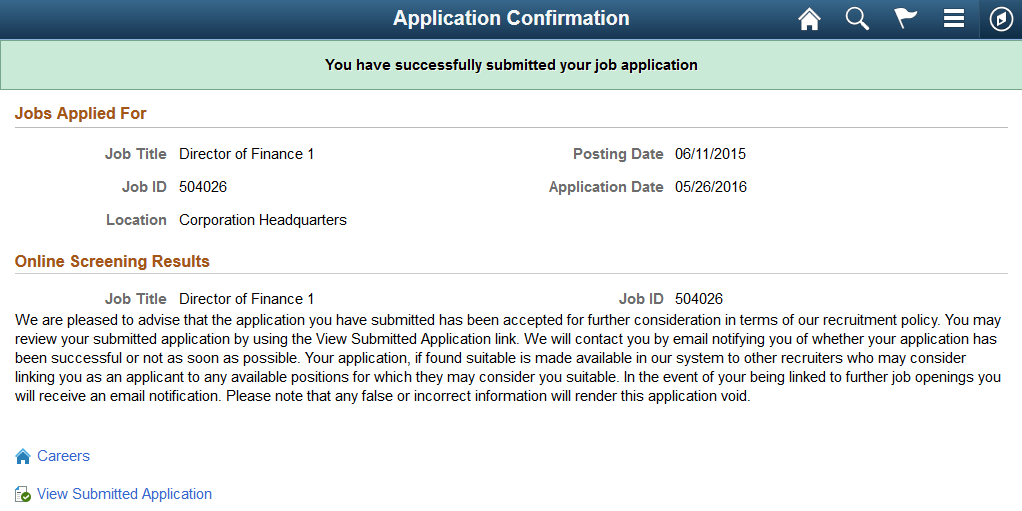
Field or Control |
Description |
|---|---|
Job Applied For |
This grid lists the jobs that were included in the submitted application. If the applicant failed prescreening for some jobs, those jobs were removed from the application and are not listed here. |
Online Screening Results |
This section appears if any there are any online screening pass or fail notices for the applicant. Pass and fail notices are optional for online screening. The notice appears after the relevant job title and job ID. If the application includes multiple jobs with online screening, the notices for jobs that use the same Explain Text ID are consolidated. That is, the titles and job IDs for all jobs using a particular notice are listed before the notice. If jobs use different Explain Text IDs, the notices appear sequentially under the appropriate job titles and IDs. |
Use the Application Summary page (HRS_CE_REVIEW_FL) to review a submitted application.
Navigation:
Click the View Submitted Application link on the Application Confirmation page.
On the My Job Applications page, access the details for an application in Submitted. status.
This example illustrates part of the Application Summary page. Additional sections that correspond to the original job application also appear on the page.

This example illustrates the Application Summary page for an application that was ended because the applicant failed prescreening.
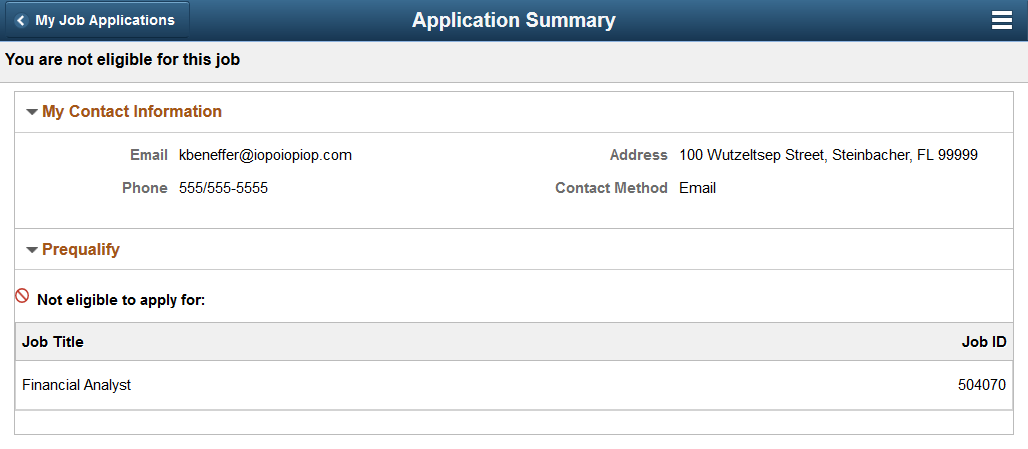
Job Application Header
If the application failed prescreening or online screening, the gray page header includes the text You are not eligible for this job.
For all other applications, the gray page header indicates which jobs, if any, the applicant applied for:
For a single-job application, the job posting title appears.
For a multi-job application, the number of jobs applied for appears (if the final count for eligible jobs is greater than 1). If the applicant failed prescreening or online screening for a subset of the jobs, that subset is not included in the count. If the count of the eligible jobs after submitting the multi-job application is 1, then the title of the eligible job appears.
For an application without a job, the text You have not selected a job appears.
Click the Job Title link to view the Job Description page with the Job Tile, Location and Job Opening ID.
Additional Application Details
The rest of the Application Summary page is a read-only version of the Review and Submit Page, rendered without the activity guide framework.
For applications that fail prescreening, the Application Summary page includes only two sections: My Contact Information and Prequalify.
 or
or  or
or  or
or 


